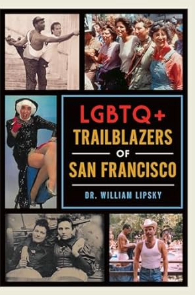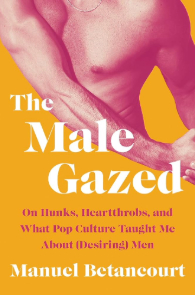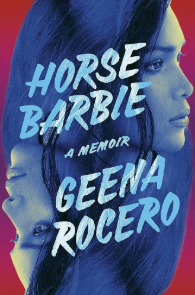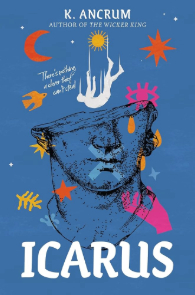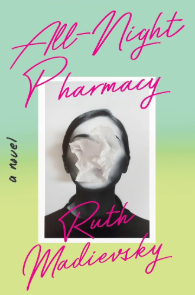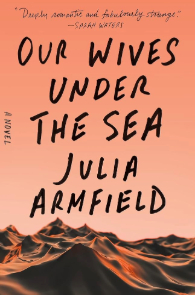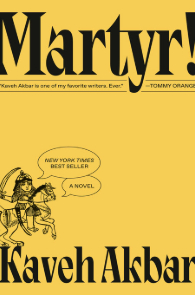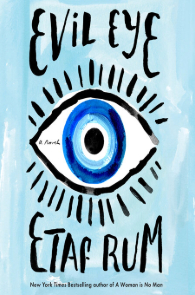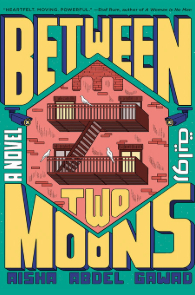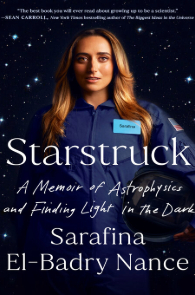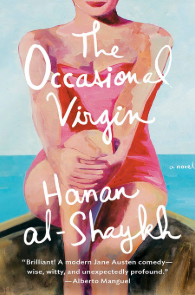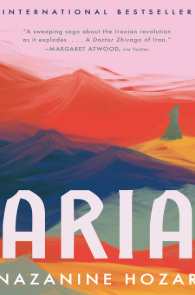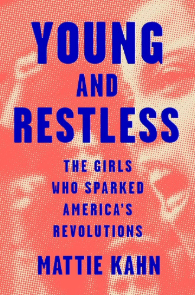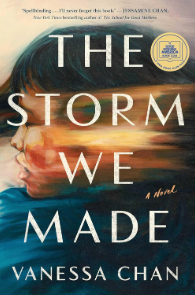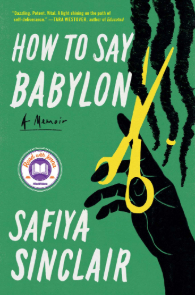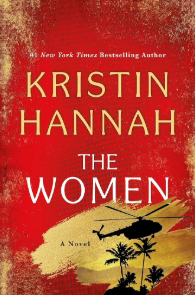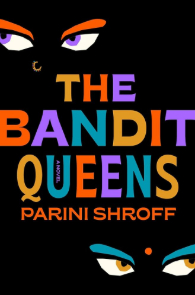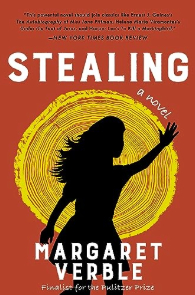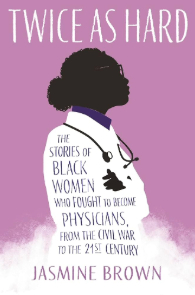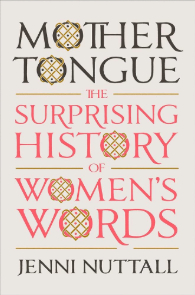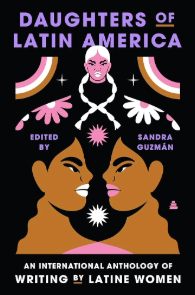Digital Humanities
Pride Month 2024

Celebrate Pride Month with our handpicked selection of books by LGBTQ+ authors and characters! Discover powerful stories that shine a light on diverse identities and experiences in the LGBTQ+ community and check out more at our Overdrive.
Dr. William Lipsky
Manuel Betancourt
Geena Rocero
K. Ancrum
Ruth Madievsky
Julia Armfield
Arab-American Heritage Month 2024
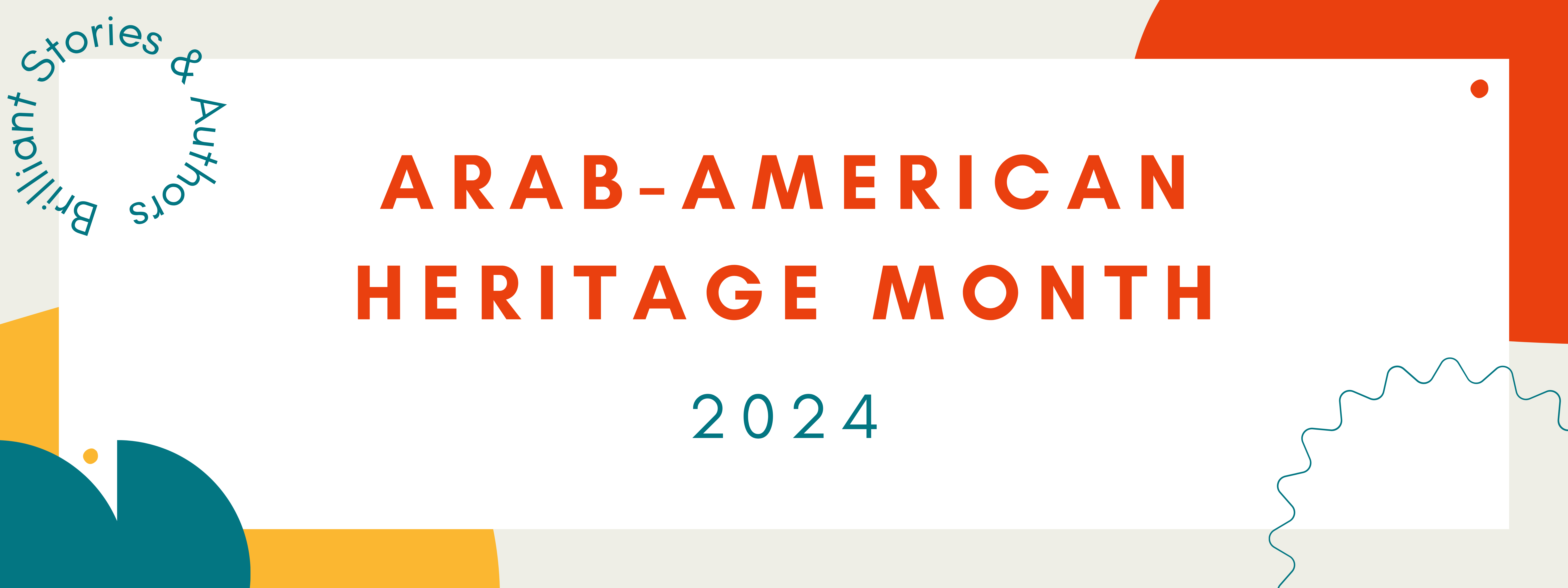
Hey there, bookworms! Ready to celebrate Arab American Heritage Month with a literary twist? Join us as we dive into the captivating world of Arab-American authors and characters and their vibrant stories, both fiction and nonfiction. Explore more at UCB Overdrive today!
Kaveh Akbar
Etaf Rum
Aisha Abdel Gawad
Sarafina El-Badry Nance
Hanan al-Shaykh
Nazanine Hozar
Women’s History Month 2024

Empowerment, inspiration, and a dash of magic: Celebrating Women’s History Month with a collection that bridges worlds, both real and imagined, penned by fierce women who redefine history, one page at a time! Check out UCB Overdrive for more great finds.
Mattie Kahn
Vanessa Chan
Safiyah Sinclair
Kristin Hannah
Parini Shroff
Margaret Verble
Jasmine Brown
Jenni Nuttall
Sandra Guzman
Graphic Narrative Art by Emily Ehlen from OHC’s Japanese American Intergenerational Narratives Oral History Project
Below are ten graphic narrative illustrations created by artist Emily Ehlen that she drew from stories and themes in the Japanese American Intergenerational Narratives Oral History Project, or JAIN project, recorded by the Oral History Center, or OHC.
The OHC’s JAIN project documents and disseminates the ways in which intergenerational trauma and healing occurred after the United States government’s mass incarceration of Japanese Americans during World War II. The OHC team interviewed twenty-three Japanese American survivors and descendants of the World War II incarceration to investigate the impacts of healing and trauma, how this informs collective memory, and how these narratives change across generations. Initial interviews in the JAIN project focused on the Manzanar and Topaz prison camps in California and Utah, respectively. The JAIN project began at the OHC in 2021 with funding from the National Park Service’s Japanese American Confinement Sites Grant. The grant provided for 100 hours of new oral history interviews, as well as funding for a new season of The Berkeley Remix podcast and for Emily Ehlen’s unique artwork below, all based on the JAIN project oral histories.
We encourage you to use and share Emily Ehlen’s artwork, along with the JAIN project oral history interviews, especially in classrooms when teaching the history and legacy of the World War II incarceration of Japanese Americans. When using these images, please credit Emily Ehlen as the artist (for example, Fig. 1, Ehlen, Emily, WAVE, digital art, 2023, Oral History Center, The Bancroft Library, University of California, Berkeley), and see the OHC website for more on permissions when using our oral histories. To save a digital copy of any illustration below for fair use, right click on the image and select “Save Image As…” The text description that accompanies each illustration below aims to provide accessibility for the visually impaired in lieu of Alt-Text limitations, which does not easily accommodate graphic narrative images. In a separate blog post, you can learn more about the artist Emily Ehlen and her processes while creating these dynamic illustrations drawn from the memories and reflections of JAIN oral history narrators.
Artist’s statement
Emily Ehlen’s illustrations for the Japanese American Intergenerational Narratives Oral History Project convey compelling narratives and imagery, with impactful shapes and color, by crafting traditionally and translating images into digital pieces. She uses text and imagery to balance the composition and support storytelling elements. Her work encompasses themes of identity and belonging, intergenerational connections, and healing. The collection navigates the impact and experiences of Japanese American incarceration during World War II and its effects on future generations.
WAVE by Emily Ehlen
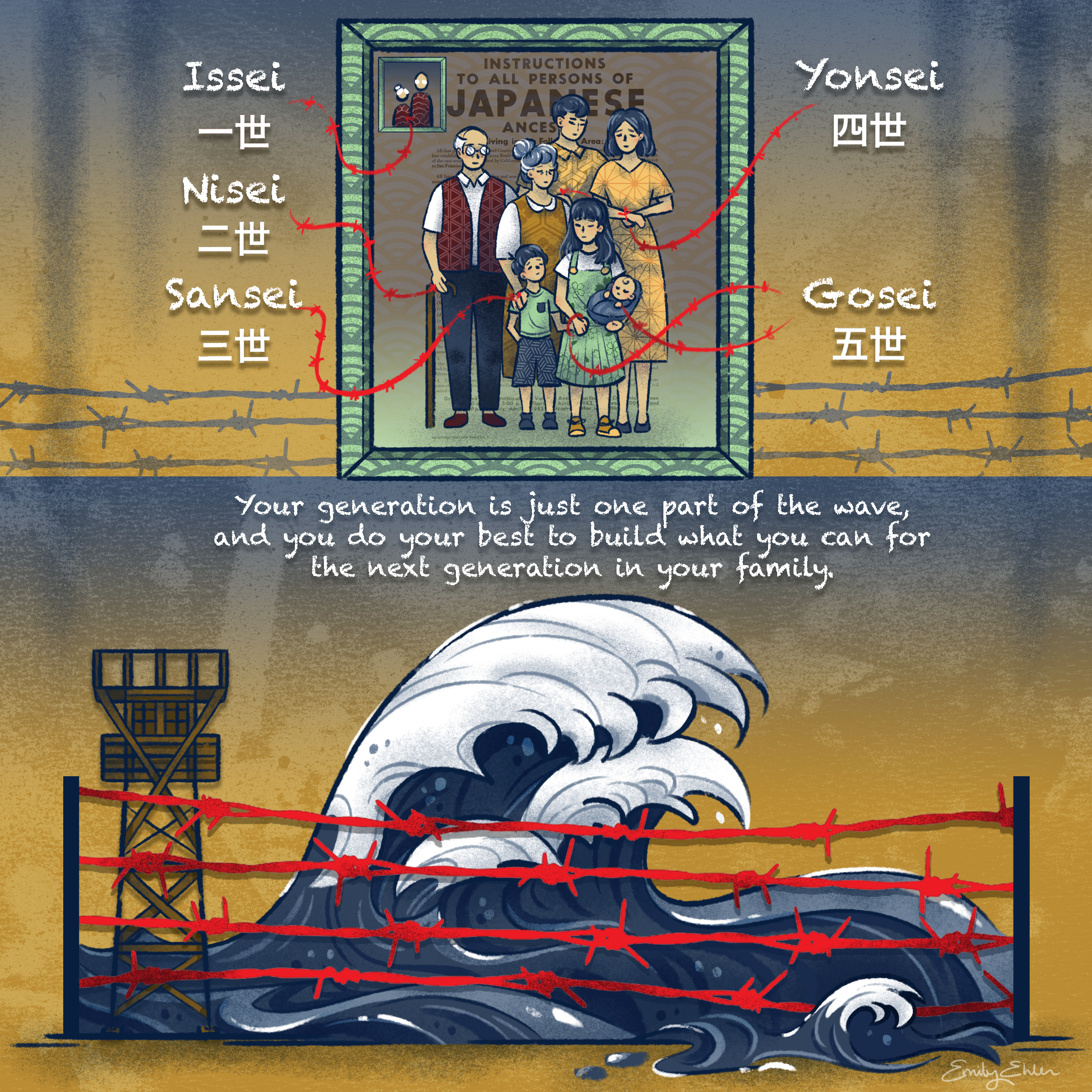
This image titled WAVE consists of two panels. The top panel depicts text that relates to the number of generations of Japanese descents surrounding a family portrait using barbed wires as arrows. The text is in romanized Japanese and kanji. It reads: “Issei,” meaning first generation; “Nisei,” meaning second generation; “Sansei,” meaning third generation; “Yonsei,” meaning fourth generation; and “Gosei,” meaning fifth generation. The bottom panel depicts a large wave and guard tower behind barbed wire with text above that reads, “Your generation is just one part of the wave, and you do your best to build what you can for the next generation in your family.”
MANZANAR by Emily Ehlen
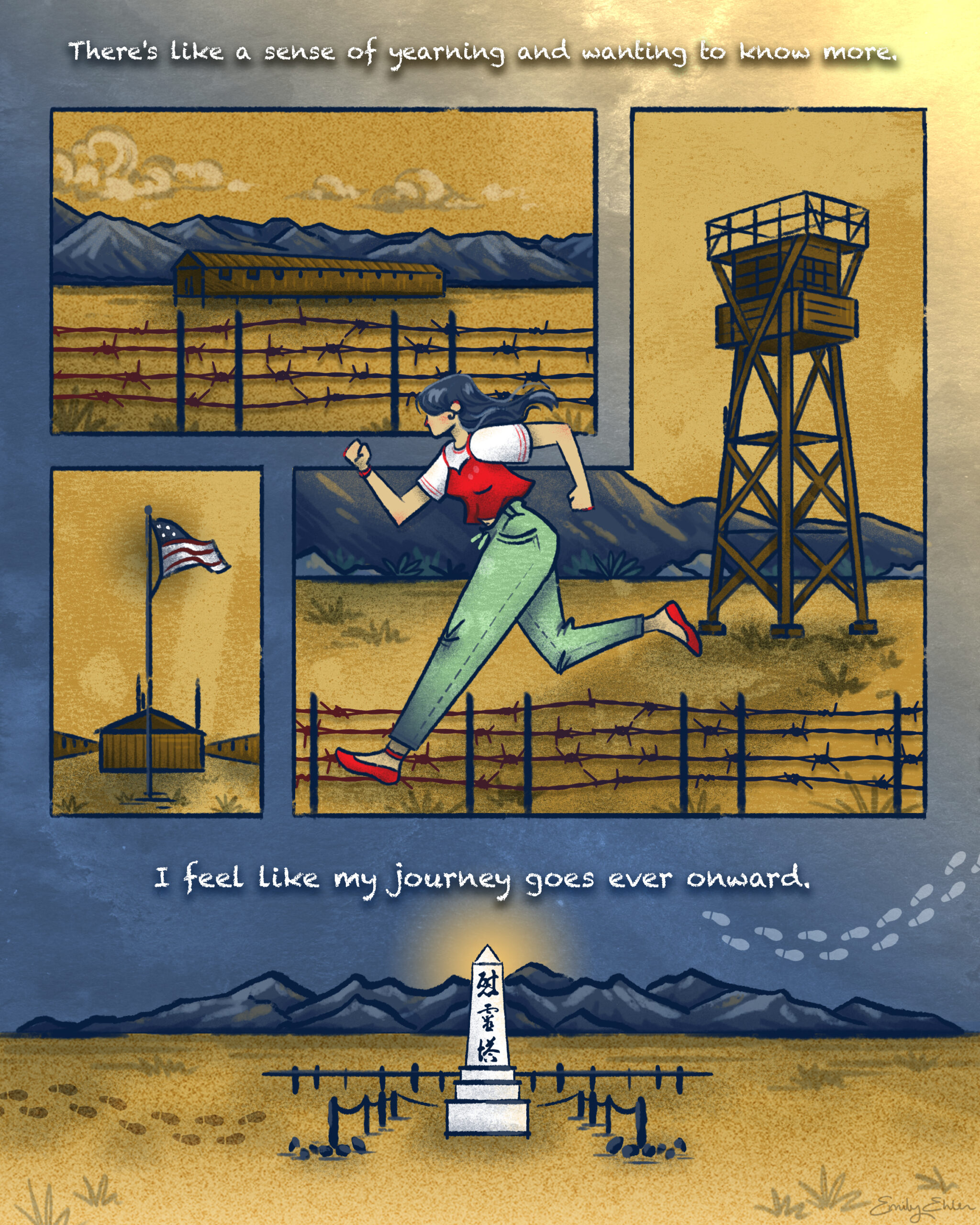
This image titled MANZANAR consists of four different panels. Each panel depicts a part of an incarceration camp and features barbed wire, the American flag, and the buildings in the camp. Above the top panel there is text that reads, “There’s like a sense of yearning and wanting to know more.” In the middle right panel, a woman in a red top layered over a white T-shirt and green pants runs towards the left of the image. The bottom panel depicts the cemetery monument at Manzanar National Historic Site, with Japanese kanji written on top, which reads, “I REI TO,” or “soul consoling tower.” Below the bottom panel there is text that reads, “I feel like my journey goes ever onward.”
STORIES by Emily Ehlen
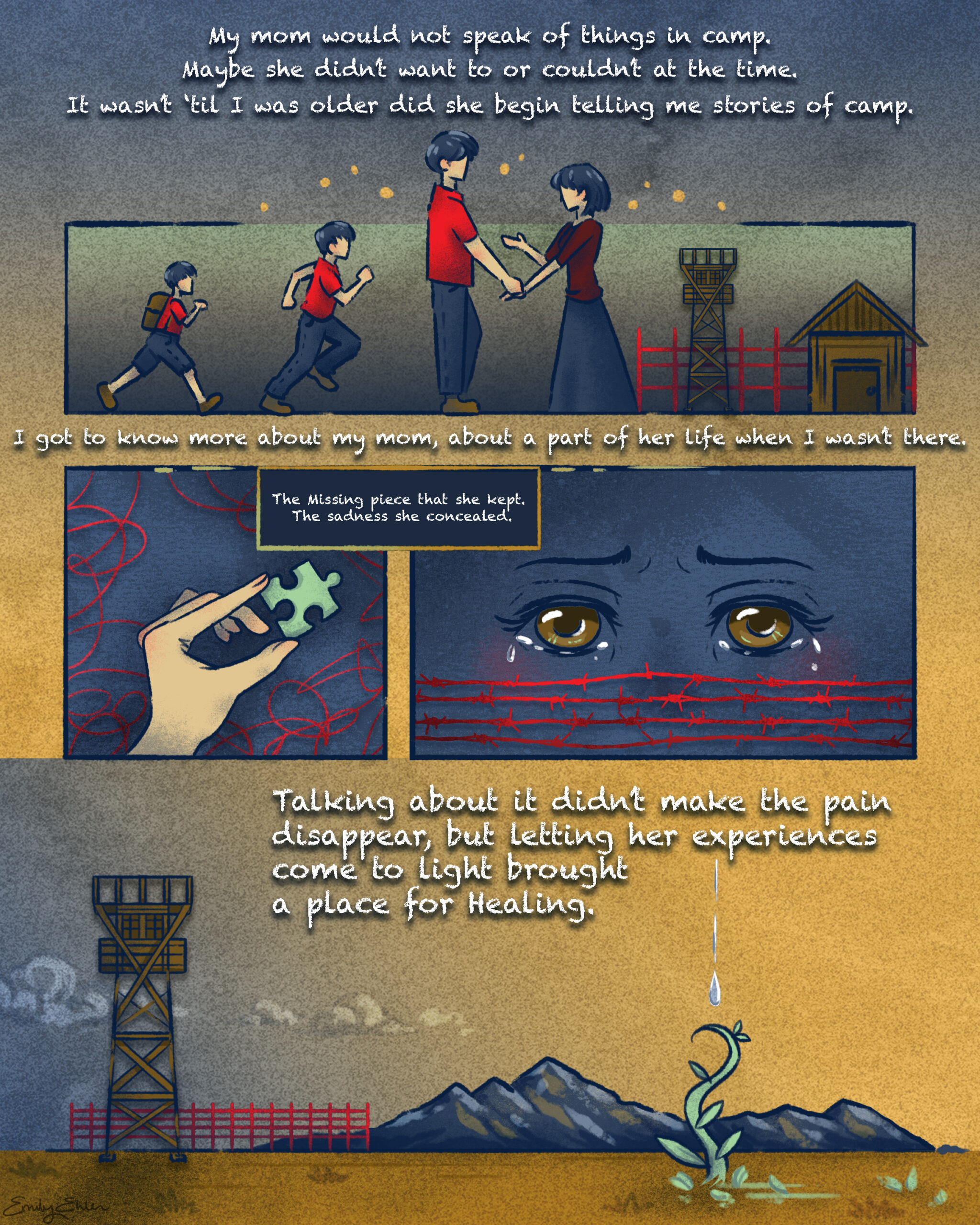
This image titled STORIES consists of four panels. The top panel depicts a growing boy talking to his mother. An incarceration camp appears behind the mother. Above this top panel, the text reads, “My mom would not speak of things in camp. Maybe she didn’t want to or couldn’t at the time. It wasn’t ’til I was older did she begin telling me stories of camp.” Under this top panel, the text reads, “I got to know more about my mom, about a part of her life when I wasn’t there.” Two middle panels follow, depicting a green puzzle piece and crying eyes behind barbed wire. The text between these panels reads, “The missing piece she kept. The sadness she concealed.” In the bottom panel, tears from the eyes above fall into a plant on the ground that is growing. The text on this panel reads, “Talking about it didn’t make the pain disappear, but letting her experiences come to light brought a place for healing.”
TEACHER by Emily Ehlen
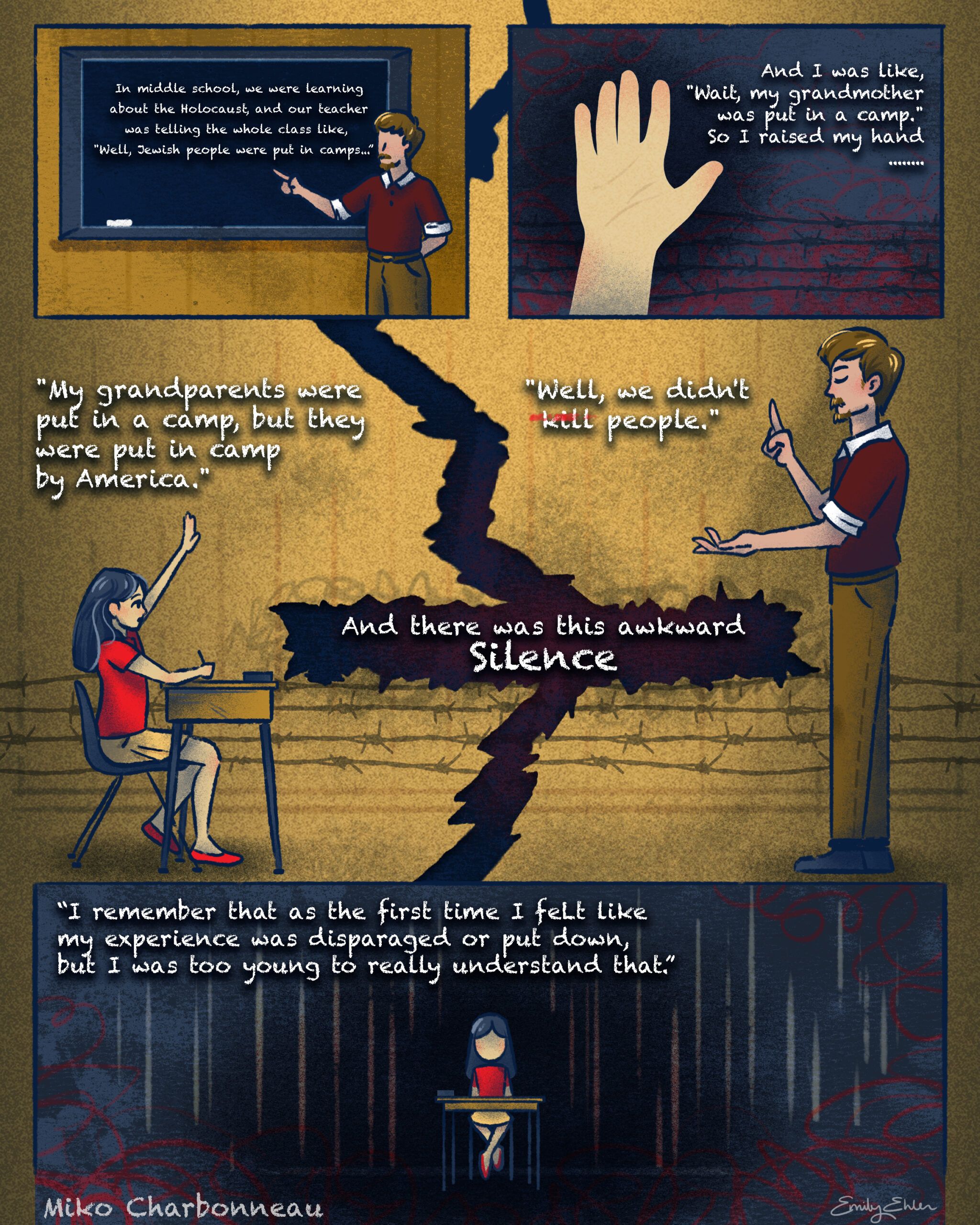
This image titled TEACHER consists of four panels. The top left panel shows a male teacher next to a chalkboard. The text on the chalkboard reads, “In middle school, we were learning about the Holocaust, and our teacher was telling the whole class like, ‘Well, Jewish people were put in camps…'” The top right panel depicts a raised hand with text that reads, “And I was like, ‘Wait, my grandmother was put in a camp.’ So I raised my hand.” The middle panel depicts a girl sitting at a desk, a male teacher standing, and a large crack between them. On the left of the panel, the girl says, “My grandparents were put in a camp, but they were put in a camp by America.” The text in the large crack reads, “And there was this awkward silence.” The teacher responds, “Well, we didn’t kill people.” The word “kill” has a red strikethrough on it. The bottom panel depicts the girl at the desk alone in the dark. The text reads, “I remember that as the first time I felt like my experience was disparaged or put down, but I was too young to really understand that.” Text on the bottom left indicates these quotations are from Miko Charbonneau’s oral history for the Japanese American Intergenerational Narratives Oral History Project.
EUCALYPTUS by Emily Ehlen
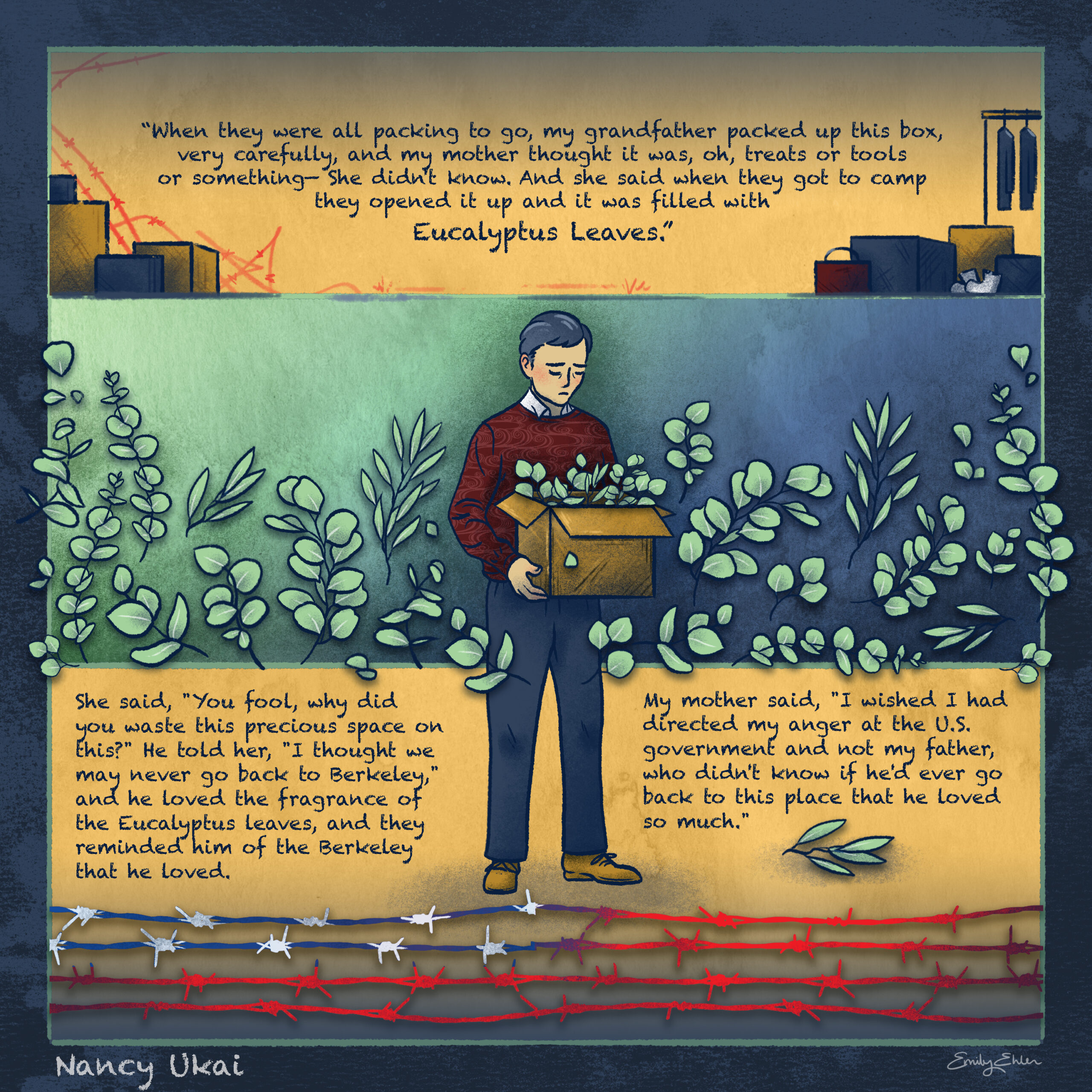
This image titled EUCALYPTUS consists of three panels. The top panel depicts suitcases and boxes of various sizes, and includes text which reads, “When they were all packing to go, my grandfather packed up this box, very carefully, and my mother thought it was, oh, treats or tools, or something—she didn’t know. And she said when they got to camp and opened it up and it was filled with Eucalyptus Leaves.” The words “eucalyptus leaves” are larger than the other words. In the center, the grandfather stands in front of all of the panels with a box of eucalyptus leaves. He is looking down with a sad expression. The bottom panel depicts some eucalyptus leaves as well as barbed wire that mimics the red, white, and blue of an American flag. This panel includes text which reads, “She said, ‘You fool, why did you waste this precious space on this?’ He told her, ‘I thought we may never go back to Berkeley,’ and he loved the fragrance of the Eucalyptus leaves, and they reminded him of the Berkeley he loved. My mother said, ‘I wished I had directed my anger at the U.S. government and not my father, who didn’t know if he’d ever go back to this place that he loved so much.'” Text on the bottom left indicates these quotations are from Nancy Ukai’s oral history for the Japanese American Intergenerational Narratives Oral History Project.
SPLASH by Emily Ehlen
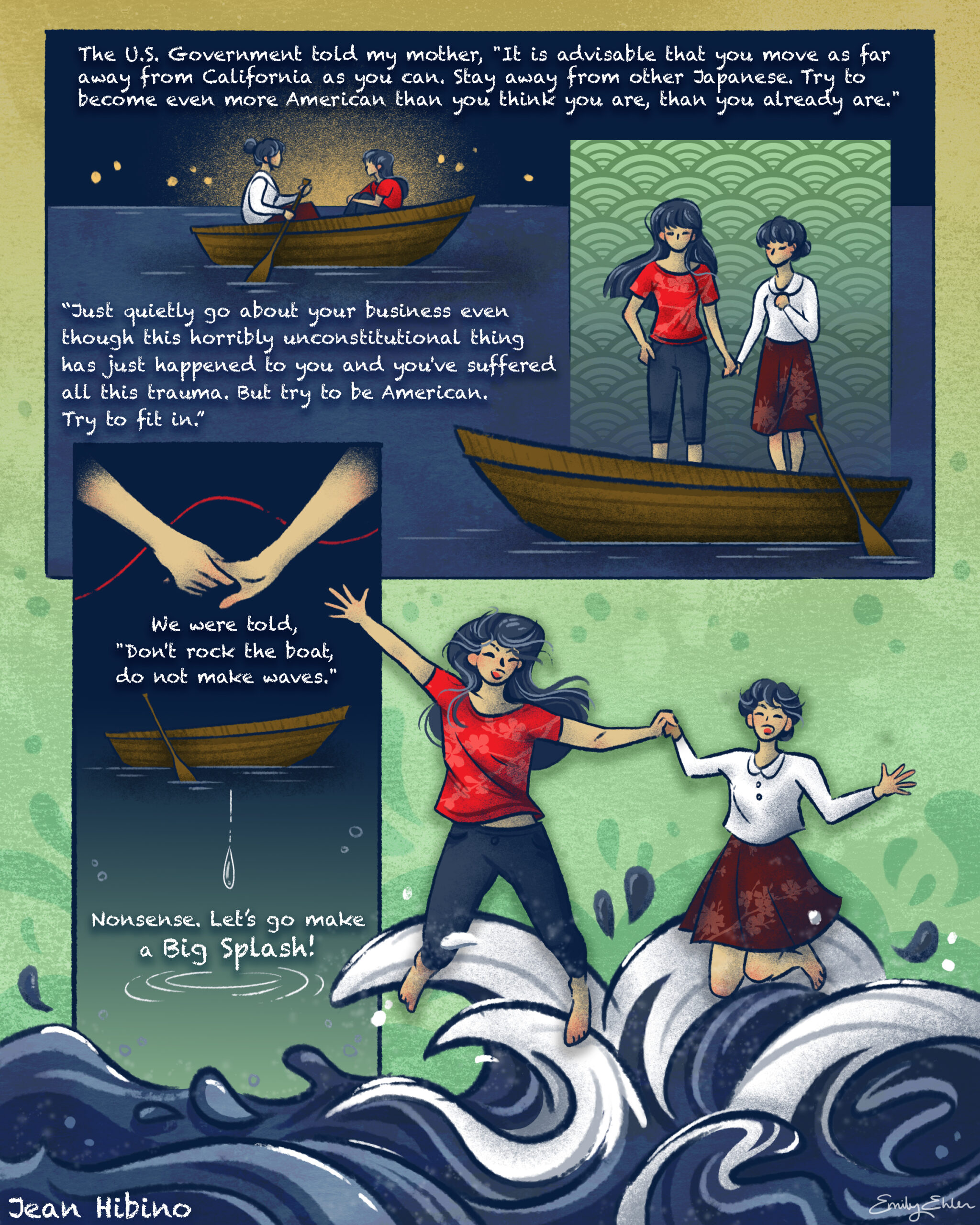
This image titled SPLASH consists of two panels on the top and two on the bottom. The top left panel depicts a younger woman and an older woman in a boat. Text above the top two panels reads, “The U.S. Government told my mother, ‘It is advisable that you move as far away from California as you can. Stay away from other Japanese. Try to become even more American than you think you are, than you already are.'” The top right panel depicts the two women holding hands and standing in the boat. The text below these panels reads,”‘Just quietly go about your business even though this horribly unconstitutional thing has just happened to you and you’ve suffered all this trauma. But try to be American. Try to fit in.'” The bottom left panel depicts a close-up of the women holding hands above the boat and a ripple in the water. Beneath the hands, the text reads, “We were told, ‘Don’t rock the boat, do not make waves.” Beneath the boat, the text reads, “Nonsense. Let’s go make a Big Splash!” The bottom right panel depicts the two women holding hands and jumping into a sea of waves. Text on the bottom left indicates these quotations are from Jean Hibino’s oral history for the Japanese American Intergenerational Narratives Oral History Project.
TOPAZ by Emily Ehlen
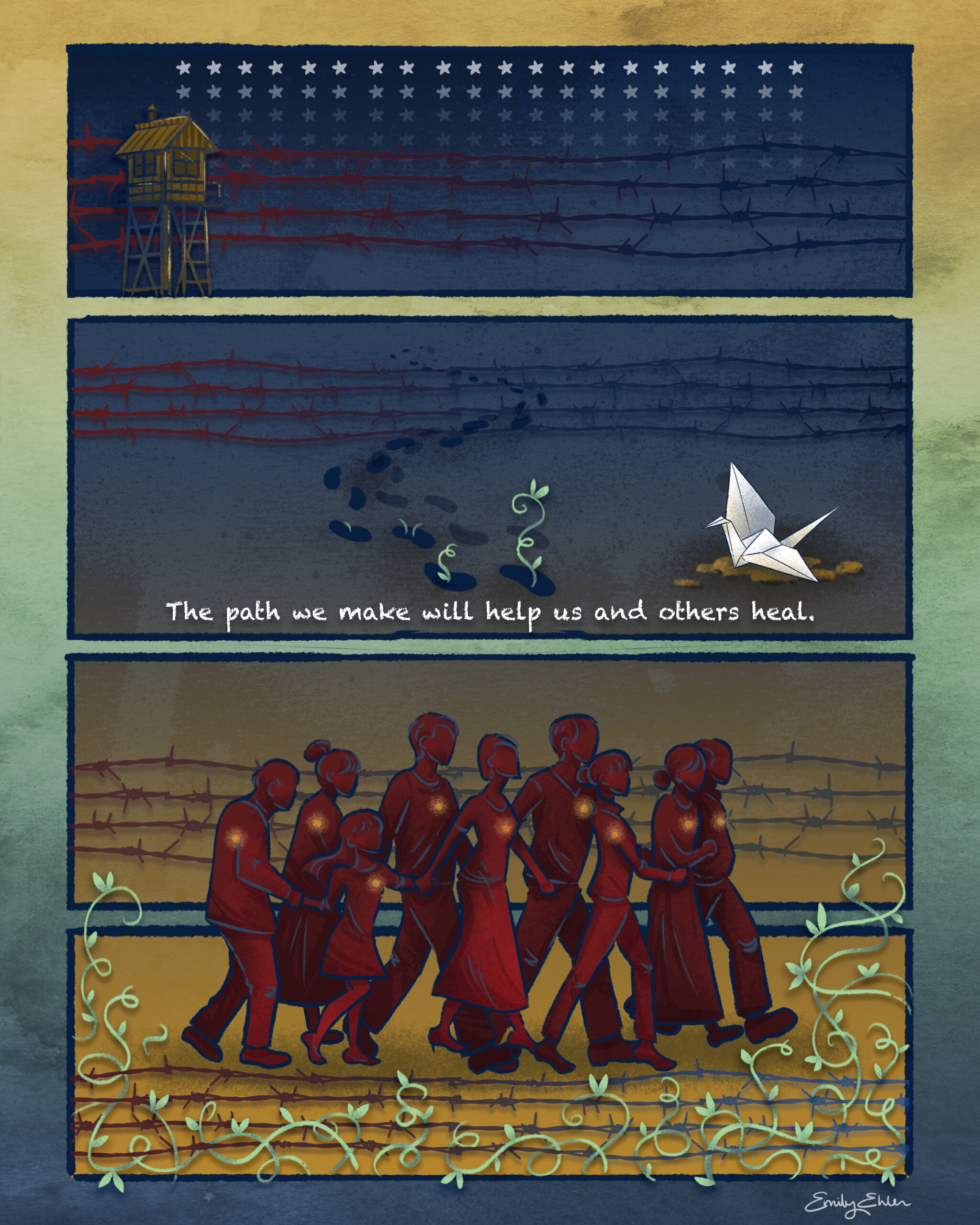
This image titled TOPAZ consists of four panels. The top panel depicts white stars behind barbed wire in red and blue that mimics the American flag, as well as a guard tower. The next panel depicts footsteps with plants sprouting from the final four steps. To the right of the footsteps, a white paper crane rests on soil. Red and blue barbed wire appears in the background. Text at the bottom of this panel reads, “The path we make will help us and others heal.” The bottom two panels depict barbed wire at the top and bottom, which frame a group of people all holding hands walking to the right. The group of people, which includes a range of ages, spans both panels. The individuals have glowing lights over their hearts. Plants sprout from the bottom of this panel.
SILENCES by Emily Ehlen
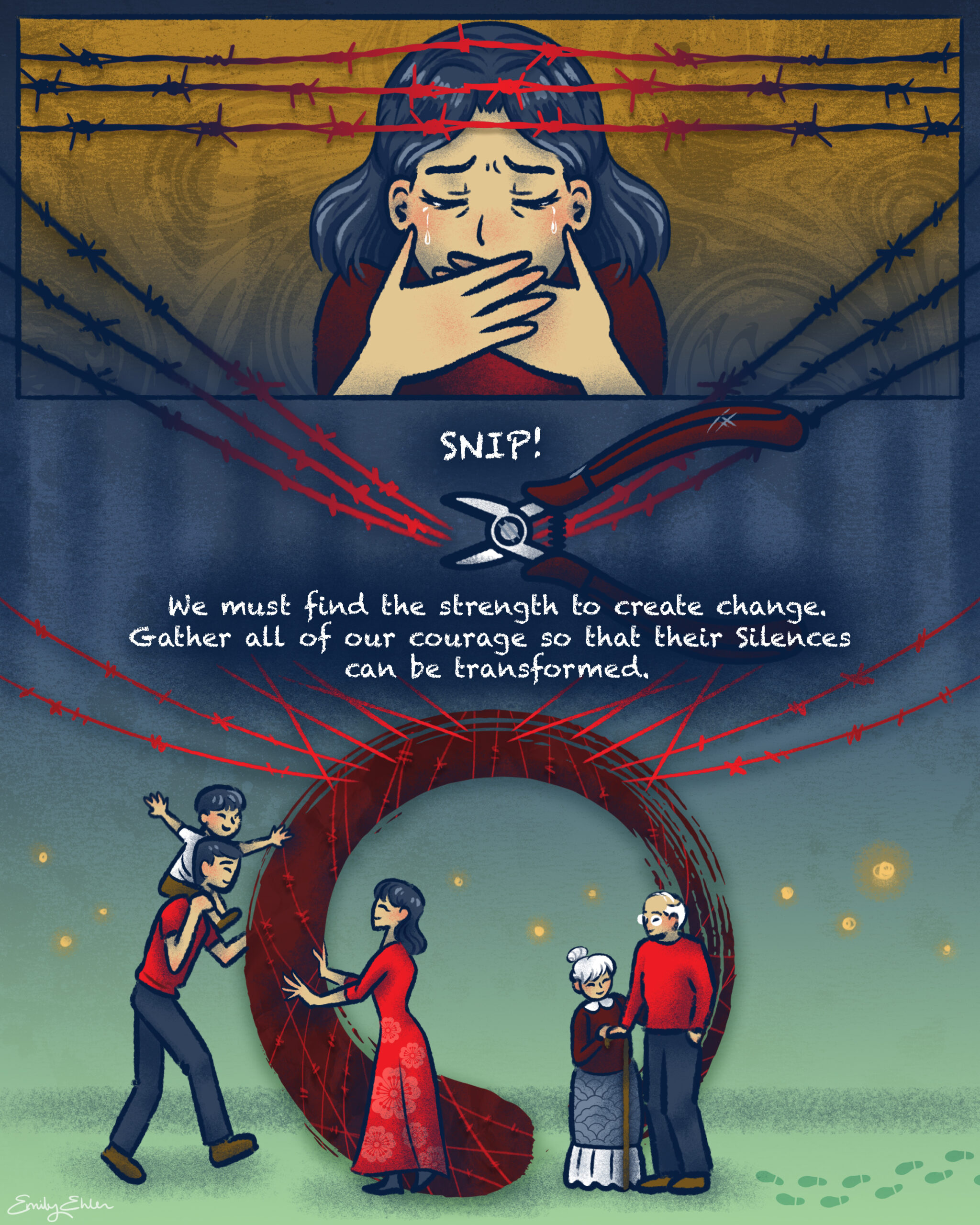
This image titled SILENCES consists of two panels. In the top panel, a woman cries while framed by red barbed wire. The bottom panel depicts wire cutters snipping the red barbed wire. Text reads, “SNIP!” Beneath the barbed wire is text that reads, “We must find the strength to create change. Gather all of our courage so that their silences can be transformed.” Beneath this text is a scene depicting a man with a child on his shoulders moving toward a woman with open arms. To the right of them are an elderly woman and man. Behind the group of people, there is a large, red circular ensō formed from the barbed wire. Glowing lights also appear in the background.
TREE by Emily Ehlen
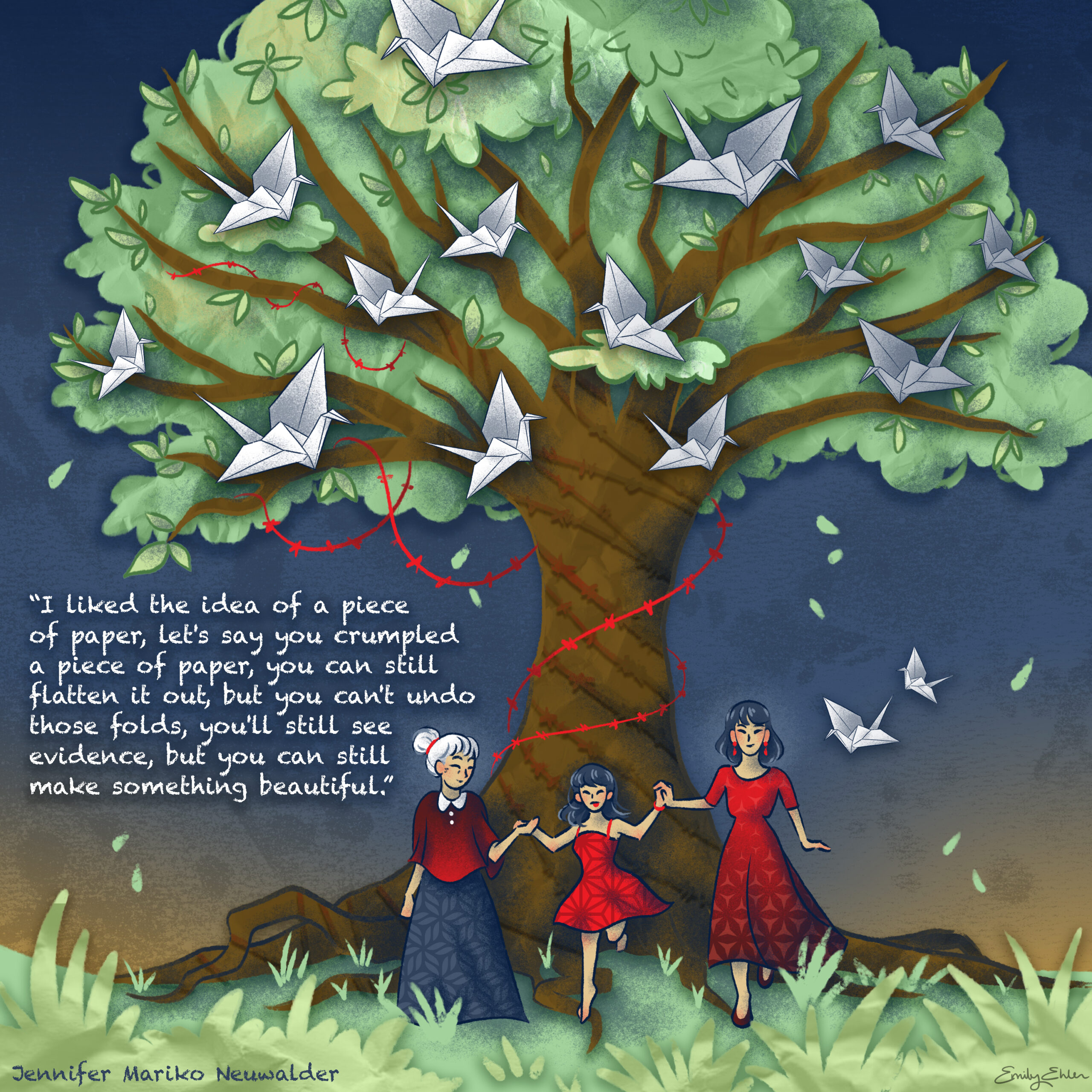
This image titled TREE consists of one panel, depicting three women of different generations holding hands in front of a large tree wrapped in red barbed wire and filled with white paper cranes. This image includes text which reads, “‘I liked the idea of a piece of paper, let’s say you crumpled a piece of paper, you can still flatten it out, but you can’t undo those folds, you’ll still see evidence, but you can still make something beautiful.” Text on the bottom left indicates these quotations are from Jennifer Mariko Neuwalder’s oral history for the Japanese American Intergenerational Narratives Oral History Project.
FEAST by Emily Ehlen
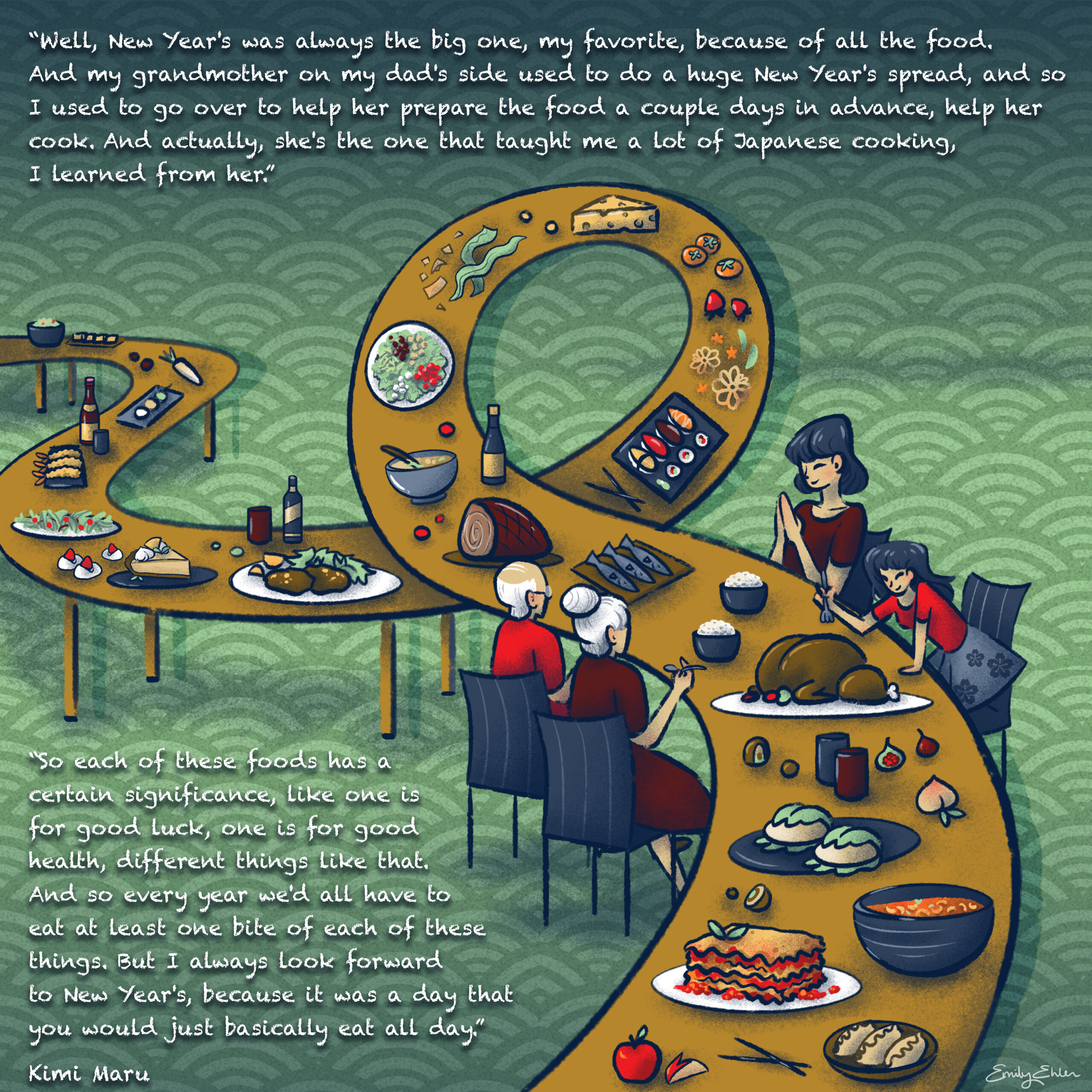
This image titled FEAST consists of one panel that depicts a long table that stretches from the left side to the bottom right which loops before reaching four people of different generations eating. The food on the table includes a variety of foods like sushi, lasagna, salad, turkey, and dumplings. Text at the top of the image reads, “‘Well, New Year’s was always the big one, my favorite, because of all the food. And my grandmother on my dad’s side used to do a huge New Year’s spread, and so I used to go over to help her prepare the food a couple days in advance, help her cook. And actually, she’s the one that taught me a lot of Japanese cooking, I learned from her.'” Text on the bottom left of the image reads,, “‘So each of these foods has a certain significance, like one is for good luck, one is for good health, different things like that. And so every year we’d all have to eat at least one bite of each of these things. But I always look forward to New Year’s, because it was a day that you would just basically eat all day.'” Text on the bottom left indicates these quotations are from Kimi Maru’s oral history for the Japanese American Intergenerational Narratives Oral History Project.
Explore the oral history interviews in the Japanese American Intergenerational Narratives Oral History Project, listen to The Berkeley Remix podcast season “’From Generation to Generation’: The Legacy of Japanese American Incarceration,” and discover related resources on the Oral History Center website.
Acknowledgments for the Japanese American Intergenerational Narratives Oral History Project
This project was funded, in part, by a grant from the U.S. Department of the Interior, National Park Service, Japanese American Confinement Sites Grant Program. The views and conclusions contained in this document are those of the authors and should not be interpreted as representing the opinions or policies of the U.S. government. Mention of trade names or commercial products does not constitute their endorsement by the U.S. Government.
This material received federal financial assistance for the preservation and interpretation of U.S. confinement sites where Japanese Americans were detained during World War II. Under Title VI of the Civil Rights Act of 1964, Section 504 of the Rehabilitation Act of 1973, and the Age Discrimination Act of 1975, as amended, the U.S. Department of the Interior prohibits discrimination on the basis of race, color, national origin, disability or age in its federally funded assisted projects. If you believe you have been discriminated against in any program, activity, or facility as described above, or if you desire further information, please write to:
Office of Equal Opportunity
National Park Service
1201 Eye Street, NW (2740)
Washington, DC 20005
ABOUT THE ORAL HISTORY CENTER
The Oral History Center of The Bancroft Library preserves voices of people from all walks of life, with varying political perspectives, national origins, and ethnic backgrounds. We are committed to open access and our oral histories and interpretive materials are available online at no cost to scholars and the public. You can find our oral histories from the search feature on our home page. Search by name, keyword, and several other criteria. Sign up for our monthly newsletter featuring think pieces, new releases, podcasts, Q&As, and everything oral history. Access the most recent articles from our home page or go straight to our blog home.
Please consider making a tax-deductible donation to the Oral History Center if you’d like to see more work like this conducted and made freely available online. The Oral History Center is a predominantly self-funded research unit of The Bancroft Library. As such, we must raise the funds to cover the cost of all the work we do, including each oral history. You can give online, or contact us at ohc@berkeley.edu for more information about our funding needs for present and future projects.
Q&A with Artist Emily Ehlen on Illustrating the OHC’s Japanese American Intergenerational Narratives Oral History Project

For the first time, the Oral History Center, or OHC, partnered with an artist named Emily Ehlen, who created ten graphic narrative illustrations based upon stories and themes recorded in the OHC’s Japanese American Intergenerational Narratives Oral History Project, or JAIN project. The JAIN project documents and disseminates the ways in which intergenerational trauma and healing occurred after the United States government’s mass incarceration of Japanese Americans during World War II.

The OHC’s JAIN project documents and disseminates the ways in which intergenerational trauma and healing occurred after the United States government’s mass incarceration of Japanese Americans during World War II. The OHC team interviewed twenty-three Japanese American survivors and descendants of the World War II incarceration to investigate the impacts of healing and trauma, how this informs collective memory, and how these narratives change across generations. Initial interviews in the JAIN project focused on the Manzanar and Topaz prison camps in California and Utah, respectively. The JAIN project began at the OHC in 2021 with funding from the National Park Service’s Japanese American Confinement Sites Grant. The grant provided for 100 hours of new oral history interviews, as well as funding for a new season of The Berkeley Remix podcast and Emily Ehlen’s unique artwork, all based on the JAIN project oral histories.
Below is an interview with Emily Ehlen about her processes in creating such dynamic illustrations drawn from the memories and reflections of JAIN oral history narrators. You can see and save copies of larger images of Emily’s artwork for the JAIN project in a separate blog post.
Artist Bio:
Emily Ehlen is best known for her colorful and whimsical illustrations using mixed media. Watercolor, ink, spray paint, and gouache are the primary mediums she uses for her traditional works, and she also integrates them in her digital pieces. She loves being positive and expressing her interests while using her surroundings as inspiration. To invoke curiosity and imagination, her drawings reflect an open view of the subject and are framed with pieces of expression and reality. Change and adaptability are a constant as she goes through various experimentations and approaches to her art.
Q&A with artist Emily Ehlen:
Q: What was your process for creating the Japanese American Intergenerational Narratives artwork?
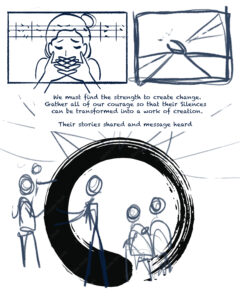
Emily Ehlen: My process started with selecting powerful imagery and phrases in relation to connecting themes found throughout the oral history transcripts. I composed thumbnails with the intent to represent the information clearly and use symbolism to convey the narrative. I wanted to use as much text from the source as I could, but I wanted to avoid it being too word heavy. It was a balancing act of editing the text and imagery to support each other in the composition and narrative. After developing and consolidating the initial drafts I moved on to tighter linework and color concepts. Once the colors were established, I inlaid patterns and handmade textures to add contrast between objects, panels, and the background. The handmade textures were made with ink washes and spray paint. The final step was applying shading and details to enhance the focus of each element while also keeping the flow throughout the entire composition.
Q: How was your work on this project similar or different to your prior art projects?
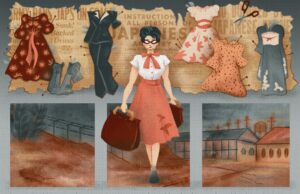
Emily Ehlen: This Japanese American Intergenerational Narratives art project was similar to the comic series Drawn to Art: Tales of Inspiring Women Artists that I worked on in 2021 for the Smithsonian American Art Museum. For that Smithsonian project, I drew a three page comic called “Weaver’s Weaver,” featuring Kay Sekimachi, a Japanese American artist. My process for both projects were pretty identical. Although, I think I had a little more freedom with expanding the storytelling elements working on the JAIN project comics. Overall, they were mutually great experiences that I am so grateful to have been a part of.
Q: How did engaging with the Japanese American Intergenerational Narratives oral history transcripts shape the stories you chose to tell and some of the imagery you used in your graphic art?
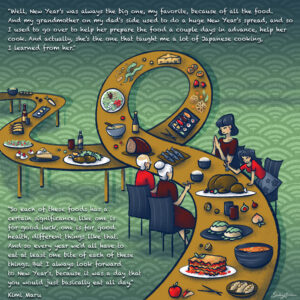
Emily Ehlen: When drafting the concepts of the illustrations, I wanted to use imagery that would convey the message the stories presented. Reading the oral history transcripts, I found lots of interesting details to include, like with the different types of food to include in the FEAST composition. It was inspiring to hear everyone’s unique voice sharing aspects about their and their family’s lives.
Q: How did you choose the various scenes and stories that you eventually depicted? What stories in the transcripts most stood out to you? Why?
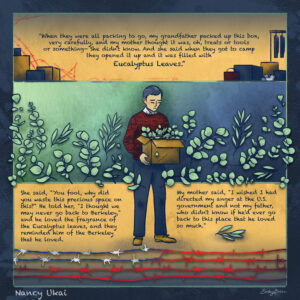
Emily Ehlen: I illustrate with the goal to portray a story the audience can connect and respond to. I wanted to choose stories with lots of emotions that I could highlight in each drawing. The piece I got the most emotional while drawing was Nancy Ukai’s grandfather in EUCALYPTUS. I sympathized with the longing and sadness of missing Berkeley that her grandfather felt. I understood the rationality behind using the box for something else, but that emphasized just how important Berkeley was to him. It was heartbreaking to read, so I knew I had to draw it.
Q: What are some of the story themes that you worked to express throughout your art for this project?
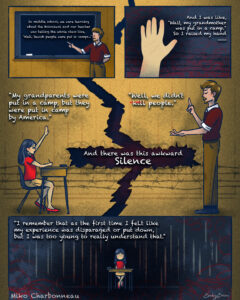
Emily Ehlen: The focus was how the Japanese American incarceration during World War II impacted themselves, their families, and how they responded to it. The themes were identity and belonging, intergenerational connections, and healing. I wanted the weight of the words to be carried through to the art accompanied with them.
Q: Can you describe some of the visual themes or repeated imagery that you incorporated throughout the various pieces you created? How and why did you develop these visual themes?

Emily Ehlen: The color palette I used helped create the tone and atmosphere of each piece separately while also keeping the collection cohesive. The red was used with duality: the bright saturated hue represented youth, rebelliousness, and intensity; while the dark maroon represented authority and repressed quietness. The soft green color was used to depict change and positivity that connects to the healing theme. The navy blue signifies unity and freedom, but it is used with a sense of serenity and heaviness. For example, the blue in TEACHER extrudes an overbearing presence in contrast to when it’s used in TREE. The ochre yellow has different meanings for its surroundings, like in TEACHER it signifies uncertainty, and in STORIES it’s used to display hope.
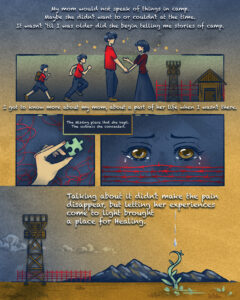
The water pattern, waves, and watercolor texture are used with family elements, and it contrasts the dry gritty spray paint texture that references the environment of Topaz and Manzanar. Waves are symbols of growth, renewal, and transformation. They also represent the unpredictability of life, to which people learn to navigate its ups and downs. The plants and paper cranes also relate to family connections, development, and healing, going through many stages and flourishing together.
For darker imagery, I wanted the red barbed wire to be synonymous with the red stripes we see on the American flag. To show the lack of freedom and injustice that the Japanese Americans faced, those stripes became wire that entrapped and left scars on following generations. The guard towers were a beacon of looming authority and danger at the incarceration camps. They became a mental block for some that were confined in their silences.
Q: While creating the JAIN art, what did you learn that was new to you?
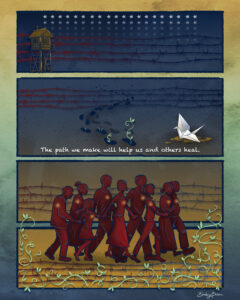
Emily Ehlen: I really enjoyed learning about everyone’s perspectives and experiences with being Japanese American. I am Chinese American, so I empathize with the stories about identity and the sense of belonging. This project lit up my desire to discover more about my culture. My motivation for drawing is to see how my art mirrors my development as a person. I think art is a record of growth and change. Like time, it never stops moving forward.
Q: Can you describe one or two of your favorite pieces that you created for this project? Why does this one stand out for you?
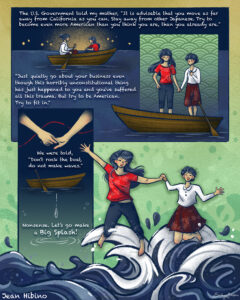
Emily Ehlen: This is like asking the question, “Who’s your favorite child?” It’s super difficult because I love each piece for different reasons. I had the most fun drawing the piece SPLASH, about Jean Hibino and her mother. I think it has the most dynamic composition with how the imagery flows together with the text. I like the sequence of stillness to movement, and how a ripple can start a wave.
Q: What are your hopes for how people engage with your art for this project? Who do you hope sees it? What do you hope people take away from your art for this project?
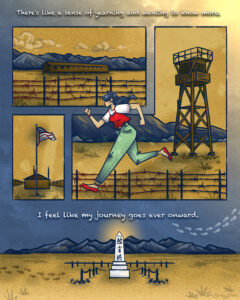
Emily Ehlen: My hope for how people engage with the comic is to have open conversations about them or topics related to it. It would be nice to see what sticks out to people the most and what connections they make through their perspectives. I hope people are able to feel the sentiments in each piece and learn new aspects of its history. I can’t think of anyone specific I’d want to see it, but I strive to be someone who inspires others by taking creative approaches to new ideas. So, I hope other artists who are interested in drawing and story-telling see it
You can see and save copies of larger images of the graphic art that Emily Ehlen created for the Japanese American Intergenerational Narratives Oral History Project in a separate blog post. We encourage you to use and share Emily Ehlen’s artwork, along with the JAIN project oral history interviews, especially in classrooms when teaching the history and legacy of the World War II incarceration of Japanese Americans. When using these images, please credit Emily Ehlen as the artist (for example, Fig. 1, Ehlen, Emily, WAVE, digital art, 2023, Oral History Center, The Bancroft Library, University of California, Berkeley), and see the OHC website for more on permissions when using our oral histories.
Acknowledgments for the Japanese American Intergenerational Narratives Oral History Project
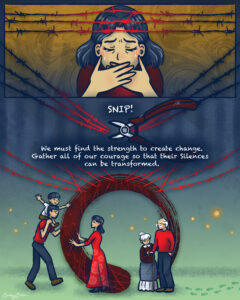
This project was funded, in part, by a grant from the U.S. Department of the Interior, National Park Service, Japanese American Confinement Sites Grant Program. The views and conclusions contained in this document are those of the authors and should not be interpreted as representing the opinions or policies of the U.S. government. Mention of trade names or commercial products does not constitute their endorsement by the U.S. Government.
This material received federal financial assistance for the preservation and interpretation of U.S. confinement sites where Japanese Americans were detained during World War II. Under Title VI of the Civil Rights Act of 1964, Section 504 of the Rehabilitation Act of 1973, and the Age Discrimination Act of 1975, as amended, the U.S. Department of the Interior prohibits discrimination on the basis of race, color, national origin, disability or age in its federally funded assisted projects. If you believe you have been discriminated against in any program, activity, or facility as described above, or if you desire further information, please write to:
Office of Equal Opportunity
National Park Service
1201 Eye Street, NW (2740)
Washington, DC 20005
ABOUT THE ORAL HISTORY CENTER
The Oral History Center of The Bancroft Library preserves voices of people from all walks of life, with varying political perspectives, national origins, and ethnic backgrounds. We are committed to open access and our oral histories and interpretive materials are available online at no cost to scholars and the public. You can find our oral histories from the search feature on our home page. Search by name, keyword, and several other criteria. Sign up for our monthly newsletter featuring think pieces, new releases, podcasts, Q&As, and everything oral history. Access the most recent articles from our home page or go straight to our blog home.
Please consider making a tax-deductible donation to the Oral History Center if you’d like to see more work like this conducted and made freely available online. The Oral History Center is a predominantly self-funded research unit of The Bancroft Library. As such, we must raise the funds to cover the cost of all the work we do, including each oral history. You can give online, or contact us at ohc@berkeley.edu for more information about our funding needs for present and future projects.
PhiloBiblon en el #DARIAHDay 2023
La Biblioteca Nacional de España se dispone a celebrar hoy el #DARIAHDAY, que debe su nombre a la red DARIAH , formada por investigadores de diferentes países europeos y en la que se proyectan casi todas las actividades de artes y humanidades digitales del Viejo Continente. El acto forma parte del programa Bibliotecas, datos, inteligencia artificial: las nuevas rutas del conocimiento (7-8 de noviembre de 2023), cuyo calendario completo se puede seguir en las redes sociales a través de la ya mencionada citada etiqueta: #DARIAHDAY
Empieza la cuenta atrás para “Bibliotecas, datos, inteligencia artificial: las nuevas rutas del conocimiento”, las jornadas que se celebrarán en la BNE los días 7 y 8 de noviembre.
Consulta aquí todas las presentaciones, coloquios y talleres
https://t.co/wqW0lvxZrh
— Biblioteca Nacional de España (@BNE_biblioteca) November 3, 2023
El Proyecto PhiloBiblon ha querido estar presente en esta convocatoria pública de proyectos de investigación de humanidades digitales; lo hemos hecho a través de un breve vídeo en el que se explica de forma concisa nuestro devenir pasado, nuestro trabajo actual y nuestros planes de futuro. Quedamos muy agradecidos a Lourdes Soriano, directora de BITECA, por su esmero y buen hacer en el diseño y en la elaboración.
Después de su estreno en el canal de Youtube de la BNE, subiremos la versión al canal de Youtube de PhiloBiblon, que recientemente se ha modificado para albergar diferentes vídeos de miembros de nuestro proyecto, sobre todo los relacionados con los Seminarios PhiloBiblon celebrados en años anteriores.
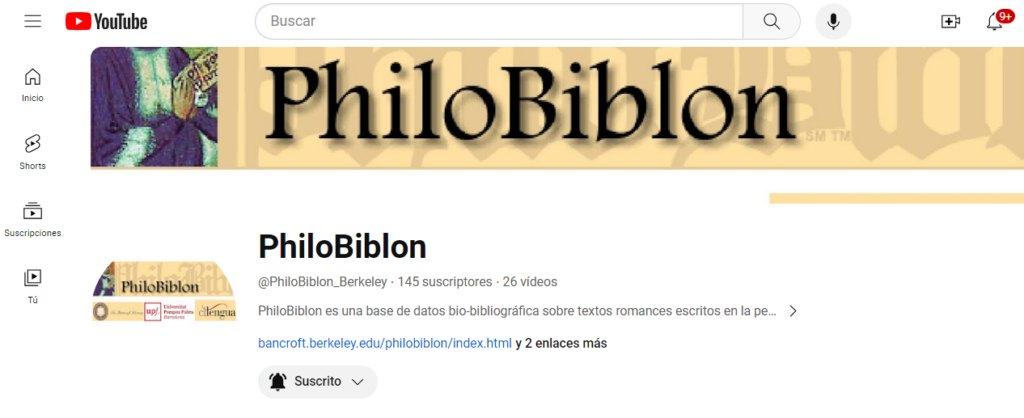
Para seguirnos en las redes sociales, lo mejor es descargarse nuestro enlace de link.tree, desde el que se puede acceder a todos nuestros perfiles.
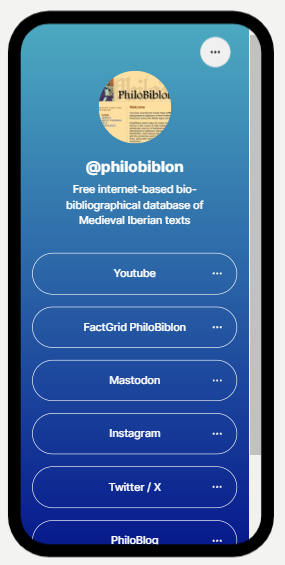
De igual forma, también podrás acceder a estos enlaces si escaneas con tu teléfono o tableta el siguiente código QR.

Un saludo cordial a nuestros lectores: esperamos que nuestra participación en el #DARIAHDAY os mantenga informados de nuestras últimas investigaciones.
PhiloBiblon 2023 n. 6 (octubre): PhiloBiblon White Paper
A requirement of the NEH Foundation grant for PhiloBiblon, “PhiloBiblon: From Siloed Databases to Linked Open Data via Wikibase: Proof of Concept” (PW-277550-21) was the preparation of a White Paper to summarize its results and provide advice and suggestions for other projects that have enthusiastic volunteers but little money:
White Paper
NEH Grant PW-277550-21
October 10, 2023
The proposal for this grant, “PhiloBiblon: From Siloed Databases to Linked Open Data via Wikibase: Proof of Concept,” submitted to NEH under the Humanities Collections and Reference Resources Foundations grant program, set forth the following goals:
This project will explore the use of the FactGrid: database for Historians Wikibase platform to prototype a low-cost light-weight development model for PhiloBiblon:
(1) show how to map PhiloBiblon’s complex data model to Linked Open Data (LD) / Resource Description Framework (RDF) as instantiated in Wikibase;
(2) evaluate the Wikibase data entry module and create prototype query modules based on the FactGrid Query Service;
(3) study Wikibase’s LD access points to and from libraries and archives;
(4) test the Wikibase data export module for JSON-LD, RDF, and XML on PhiloBiblon data,
(5) train PhiloBiblon staff in the use of the platform;
(6) place the resulting software and documentation on GitHub as the basis for a final “White Paper” and follow-on implementation project.
A Wikibase platform would position PhiloBiblon to take advantage of current and future semantic web developments and decrease long-term sustainability costs. Moreover, we hope to demonstrate that this project can serve as a model for low-cost light-weight database development for similar academic projects with limited resources.
PhiloBiblon is a free internet-based bio-bibliographical database of texts written in the various Romance vernaculars of the Iberian Peninsula during the Middle Ages and the early Renaissance. It does not contain the texts themselves; rather it attempts to catalog all their primary sources, both manuscript and printed, the texts they contain, the individuals involved with the production and transmission of those sources and texts, and the libraries holding them, along with relevant secondary references and authority files for persons, places, and institutions.
It is one of the oldest digital humanities projects in existence, and the oldest in the Hispanic world, starting out as an in-house database for the Dictionary of the Old Spanish Language project (DOSL) at the University of Wisconsin, Madison, in 1972, funded by NEH. Its initial purpose was to locate manuscripts and printed texts physically produced before 1501 to provide a corpus of authentic lexicographical material for DOSL. It soon became evident that the database would also be of interest to scholars elsewhere; and a photo-offset edition of computer printout was published in 1975 as the Bibliography of Old Spanish Texts (BOOST). It contained 977 records, each one listing a given text in a given manuscript or printed edition. A second edition followed in 1977 and a third in 1984.
PhiloBiblon was published in 1992 on CD-ROM, incorporating not only the materials in Spanish but also those in Portuguese and Catalan. By this time BOOST had been re-baptized as BETA (Bibliografía Española de Textos Antiguos), while the Portuguese corpus became BITAGAP (Bibliografia de Textos Antigos Galegos e Portugueses) and the Catalan corpus BITECA (Bibliografia de Textos Antics Catalans, Valencians i Balears). PhiloBiblon was ported to the web in 1997; and the web version was substantially re-designed in 2015. PhiloBiblon’s three databases currently hold over 240,000 records.
All of this data has been input manually by dozens of volunteer staff in the U.S., Spain, and Portugal, either by keyboarding or by cutting-and-pasting, thousands of hours of unpaid labor. That unpaid labor has been key to expanding the databases, but just as important, and much more difficult to achieve, has been the effort to keep up with the display and database technology. The initial database management system (DBMS) was FAMULUS running on the Univac 1110 at Madison, a flat-file DBMS originally developed at Berkeley in 1964. In 1985 the database was mapped to SPIRES (Stanford Public Information Retrieval System) and then, in 1987, to a proprietary relational DBMS, Revelation G, running on an IBM PC.
Today we continue to use Revelation Technology’s OpenInsight on Windows, the lineal descendent of Revelation G. We periodically export data from the Windows database in XML format and upload it to a server at Berkeley, where the XTF (eXtensible Text Framework) program suite parses it into individual records, indexes it, and serves it up on the fly in HTML format in response to queries from users around the world. The California Digital Library developed XTF as open source software ca. 2010, but it is now in the process of being phased out and is no longer supported by the UC Berkeley Library.
The need to find a substitute for XTF caused us to rethink our entire approach to the technologies that make PhiloBiblon possible. Major upgrades to the display and DBMS technology, either triggered by technological change or by a desire to enhance web access, have required significant grant support, primarily from NEH, eleven NEH grants from 1989 to 2021. We applied for the current grant in the hope that it would show us how to get off the technology merry-go-round. Instead of seeking major grant support every five to seven years for bespoke technology, this pilot project was designed to demonstrate that we could solve our technology problems for the foreseeable future by moving PhiloBiblon to Wikibase, the technology underlying Wikipedia and Wikidata. Maintained by Wikimedia Deutschland, the software development arm of the Wikimedia Foundation, Wikibase is made available for free. With Wikibase,we would no longer have to raise money to support our software infrastructure.
We have achieved all of the goals of the pilot project under this current grant and placed all of our software development work on GitHub (see below). We received a follow-on two-year implementation grant from NEH and on 1 July 2023 began work to map all of the PhiloBiblon data from the Windows DBMS to FactGrid.
❧ ❧ ❧
For the purposes of this White Paper, I shall focus on the PhiloBiblon pilot project as a model for institutions with limited resources for technology but dedicated volunteer staff. There are thousands of such institutions in the United States alone, in every part of the country, joined in national and regional associations, e.g., the American Association for State and Local History, Association of African American Museums, Popular Culture Association, Asian / Pacific / American Archives Survey Project, Southeastern Museums Conference. Many of their members are small institutions that depend on volunteer staff and could use the PhiloBiblon model to develop light-weight low-cost databases for their own projects. In the San Francisco Bay Area alone, for example there are dozens of such small cultural heritage institutions (e.g., The Beat Museum, GLBT Historical Society Archives, Holocaust Center Library and Archives, Berkeley Architectural History Association.
To begin at the beginning: What is Linked Open Data and why is it important?
What is Wikibase, why use it, and how does it work?
Linked Open Data (LOD) is the defining principle of the semantic web: “globally accessible and linked data on the internet based on the standards of the World Wide Web Consortium (W3C), an open environment where data can be created, connected and consumed on internet scale.”
Why use it? Simply, data has more value if it can be connected to other data, if it does not exist in a silo.
Wikibase in turn is the “free software for open data projects. It connects the knowledge of people and organizations and enables them to open their linked data to the world.” It is one of the backbone technologies of the LOD world.
Why use it? The primary reason to use Wikibase is precisely to make local or specialized knowledge easily available to the rest of the world by taking advantage of LOD, the semantic web. Conversely, the semantic web makes it easier for local institutions to take advantage of LOD.
How does Wikibase work? The Wikibase data model is deceptively simple. Each record has a “fingerprint” consisting of a Label, a Description, and an optional Alias. This fingerprint uniquely identifies the record. It can be repeated in multiple languages, although in every case the Label and the Description in the other languages must also be unique. Following the fingerprint header comes a series of three-part statements (triples, triplestores) that link a (1) subject Q to an (2) object Q by means of a (3) property P. The new record itself is the subject, to which Wikibase assigns automatically a unique Q#. There is no limit, except that of practicality, to the number of statements that a record can contain. They can be input in any order, and new statements are simply appended at the end of the record. No formal ontology is necessary, although having one is certainly useful, as librarians have discovered over the past sixty years. Must records start with a statement of identity, e.g.: Jack Keraouc (Q160534) [is an] Instance of (P31) Human (Q5).[1] Each statement can be qualified with sub-statements and footnoted with references. Because Wikibase is part of the LOD world, each record can be linked to the existing rich world of LOD identifiers: Jack Keraouc (Q160534) in the Union List of Artist Names ID (P245) is ID 500290917.
Another important reason for using Wikibase is the flexibility that it allows in tailoring Q items and P properties to the needs of the individual institution. There is no need to develop an ontology or schema ahead of time; it can be developed on the fly, so to speak. There is no need to establish a hierarchy of subject headings, for example, like that of the Library of Congress as set forth in the Library of Congress Subject Headings (LCSH). LC subject headings can be extended as necessary or entirely ignored. Other kinds of data can also be added:
New P properties to establish categories: nicknames, associates (e.g., other members of a rock band), musical or artistic styles);
New Q items related to the new P properties (e.g., the other members of the band).
There is no need to learn the Resource Description Access (RDA) rules necessary for highly structured data, such as MARC or its eventual replacement, BIBFRAME. This in turn means that data input does not need persons trained in librarianship.
How would adoption of Wikibase to catalog collections, whether of books, archival materials, or physical objects, work in practice? What decisions must be made? The first decision is simply whether (1) to join Wikidata or (2) set up a separate Wikibase instance (like FactGrid).[2] The former is far simpler. It requires no programming experience at all and very little knowledge of data science. Joining Wikidata simply means mapping the institution’s current database to Wikidata through a careful analysis of the database in comparison with Wikidata. For example, a local music history organization, like the SF Music Hall of Fame, might want to organize an archive of significant San Francisco musicians.
The first statement in the record of rock icon Jerry García might be Instance of (P31) Human (Q5); a second statement might be Sex or Gender (P21) Male (Q6581097); and a third, Occupation (P106) Guitarist (Q855091).
Once the institutional database properties have been matched to the corresponding Wikidata properties, the original database must be exported as a CSV (comma separated values) file. Its data must then be compared systematically to Wikidata through a process known as reconciliation, using the open source OpenRefine tool. This same reconciliation process can be used to compare the institutional database to a large number of other LOD services through Mix n Match, which lists hundreds of external databases in fields ranging alphabetically from Art to Video games. Thus the putative SF Music Hall of Fame database might be reconciled against the large Grammy Awards (5700 records) database of the Recording Academy.
Reconciliation is important because it establishes links between records in the institutional database and existing records in the LOD world. If there are no such records, the reconciliation process creates new records that automatically become part of the LOD world.
One issue to consider is that, like Wikipedia, anyone can edit Wikidata. This has both advantages and disadvantages. The advantage is that outside users can correct or expand records created by the institution. The disadvantage is that a malicious user or simply a well-intentioned but poorly informed one can also damage records by the addition of incorrect information.
In the implementation of the new NEH grant (2023-2025), we hope to have it both ways. Our new user interface will allow, let us say, a graduate student looking at a medieval Spanish manuscript in a library in Poland to add information about that manuscript through a template. However, before that information can be integrated into the master database, it would have to be vetted by a PhiloBiblon editorial committee.
The second option, to set up a separate Wikibase instance, is straightforward but not simple. The Wikibase documentation is a good place to start, but it assumes a fair amount of technical expertise. Matt Miller (currently at the Library of Congress) has provided a useful tutorial, Wikibase for Research Infrastructure , explaining how to set up a Wikibase instance and the steps required to go about it. Our programmer, Josep Formentí, has made this more conveniently available on a public GitHub repository, Wikibase Suite on Docker, which installs a standard collection of Wikibase services via Docker Compose V:
Wikibase
Query Service
QuickStatements
OpenRefine
Reconcile Service
The end result is a local Wikibase instance, like the one created by Formentí on a server at UC Berkeley as part of the new PhiloBiblon implementation grant: PhiloBiblon Wikibase instance. He used as his basis the suite of programs at Wikibase Release Pipeline. Formentí has also made available on GitHub his work on the PhiloBiblon user interface mentioned above. This would serve PhiloBiblon as an alternative to the standard Wikibase interface.
Once the local Wikibase instance has been created, it is essentially a tabula rasa. It has no Properties and no Items. The properties would then have to be created manually, based on the structure of the existing database or on Wikidata. By definition, the first property will be P1. Typically it will be “Instance of,” corresponding to Instance of (P31) in Wikidata.
The Digital Scriptorium project, a union catalog of medieval manuscripts in North American libraries now housed at the University of Pennsylvania, went through precisely this process when it mapped 67 data elements to Wikibase properties created specifically for that project. Thus property P1 states the Digital Scriptorium ID number; P2 states the current holding institution, etc.
Once the properties have been created, the next step is to import the data in a batch process, as described above, by reconciling it with existing databases. Miller explains alternative methods of batch uploads using python scripts.
Getting the initial upload of institutional data into Wikidata or a local Wikibase instance is the hard part, but once that initial upload has been accomplished, all data input from then on can be handled by non-technical staff. To facilitate the input of new records, properties can be listed in a spreadsheet in the canonical input order, with the P#, the Label, and a short Description. Most records will start with the P1 property “Institutional ID number” followed by the value of the identification number in the institutional database. The Cradle or Shape Expressions tools, with the list of properties in the right order, can generate a ready-made template for the creation of new records. Again, this is something that an IT specialist would implement during the initial setup of a local Wikibase instance.
New records can be created easily by inputting statements following the canonical order in the list of properties. New properties can also be created if it is found, over time, that relevant data is not being captured. For example, returning to the Jerry García example, it might be useful to specify “rock guitarist”(Q#) as a subclass of “guitarist.”
The institution would then need to decide whether the local Wikibase instance is to be open or closed. If it were entirely open, it would be like Wikidata, making crowd-sourcing possible. If it were closed, only authorized users could add or correct records. PhiloBiblon is exploring a third option for its user interface, crowdsourcing mediated by an editorial committee that would approve additions or changes before they could be added to the database.
One issue remains, searching:
Wikibase has two search modes, one of which is easy to use, and one of which is not.
- The basic search interface is the ubiquitous Google box. As the user types in a request, the potential records show up below it until the user sees and clicks on the requested record. If no match is found, the user can then opt to “Search for pages containing [the search term],” which brings up all the pages in which the search term occurs, although there is no way to sort them. They show up neither in alphabetical order of the Label nor in numerical order of the Q#.
- More precise and targeted searches must make use of the Wikibase Query Service, which opens a “SPARQL endpoint,” a window in which users can program queries using the SPARQL query language. SPARQL pronounced “sparkle,” is a recursive acronym for “SPARQL Protocol And RDF Query Language,” designed by and for the World Wide Web Consortium (WC3) as the standard language for LOD triplestores, just as SQL (Structured Query Language) is the standard language for relational database tables.
SPARQL is not for the casual user. It requires some knowledge of SPARQL or similar query languages as well as of the specifics of Wikibase items and properties. Many Wikibase installations offer “canned” SPARQL queries. In Wikidata, for example, one can use a canned query to find all of the pictures of the Dutch artist Jan Vermeer and plot their current locations on a map, with images of the pictures themselves. In fact, Wikidata offers over 400 examples of canned queries, each of which can then serve as a model for further queries.
How, then, to make more sophisticated searches available for those who do not wish to learn SPARQL?
For PhiloBiblon we are developing masks or templates to facilitate searching for, e.g., persons, institutions, works. Thus, the institutions mask allows for searches for free text, the institution, its location, its type (e.g., university), and subject headings:
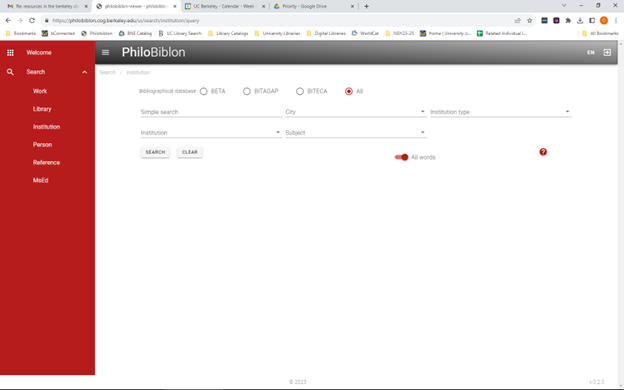
This mimics the search structure of the PhiloBiblon legacy website:
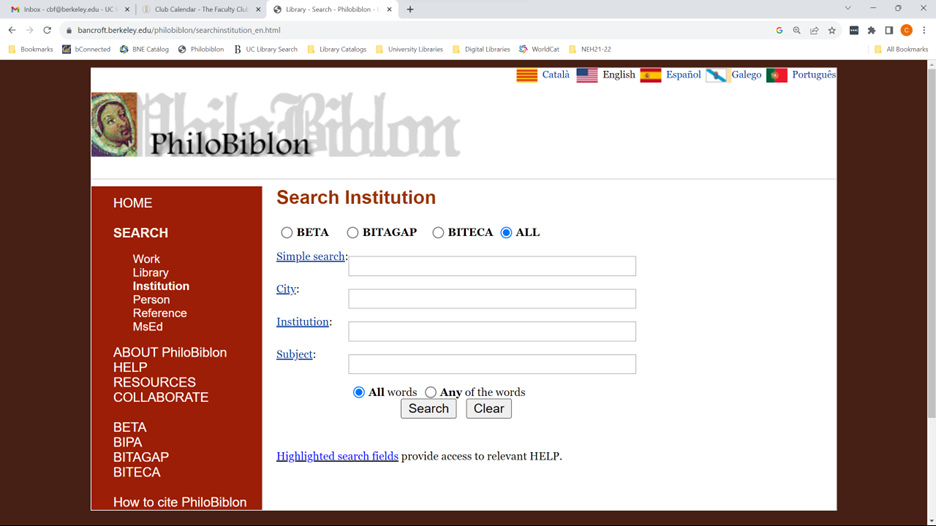
The use of templates does not, however, address the problem of searching across different types of objects or of providing different kinds of outputs. For example, one could not use such a template to plot the locations and dates of Franciscans active in Spain between 1450 and 1500. For this one needs a query language, i.e., SPARQL.
We have just begun to consider this problem under the new NEH implementation grant. It might be possible to use a Large Language Model query service such as ChatGPT or Bard as an interface to SPARQL. A user might send a prompt like this: “Write a SPARQL query for FactGrid to find all Franciscans active in Spain between 1450 and 1500 and plot their locations and dates on a map and a timeline.” This would automatically invoke the SPARQL query service and return the results to the user in the requested format.
Other questions and considerations will undoubtedly arise for any institution or project contemplating the use of Wikibase for its database needs. Nevertheless, we believe that we have demonstrated that this NEH-funded project can serve as a model for low-cost light-weight database development for small institutions or similar academic projects with limited resources.
Questions may be addressed to Charles Faulhaber (cbf@berkeley.edu).
[1] For the sake of convenience, I use the Wikidata Q# and P# numbers.
[2] For a balanced discussion of whether to join Wikidata or set up a local Wikibase instance, see Lozana Rossenova, Paul Duchesne, and Ina Blümel, “Wikidata and Wikibase as complementary research data management services for cultural heritage data.” The 3rd Wikidata Workshop, Workshop for the scientific Wikidata community, @ ISWC 2022, 24 October 2022. CEUR_WS, vol-3262.
Charles Faulhaber
University of California, Berkeley
Free large-format scanning for UC Berkeley students, faculty, and staff
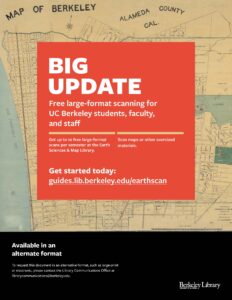 Members of the UC Berkeley community can now get up to 10 free large-format scans per semester at the Earth Sciences & Map Library! This can include maps or other large, flat materials. Scans over the free allotment are $10 each. For walk-in patrons not affiliated with the university, the cost is $25 per scan. Get more information about large-format scanning, or visit the library to start your scanning project.
Members of the UC Berkeley community can now get up to 10 free large-format scans per semester at the Earth Sciences & Map Library! This can include maps or other large, flat materials. Scans over the free allotment are $10 each. For walk-in patrons not affiliated with the university, the cost is $25 per scan. Get more information about large-format scanning, or visit the library to start your scanning project.“Robert Cox: Sierra Club President 1994-96, 2000-01, and 2007-08, on Environmental Communications and Strategy,” oral history release
New oral history: “Robert Cox: Sierra Club President 1994-96, 2000-01, and 2007-08, on Environmental Communications and Strategy”
Video clip from Robert Cox’s oral history on the Sierra Club’s environmental justice work with Jesus People Against Pollution (JPAP) in 1994
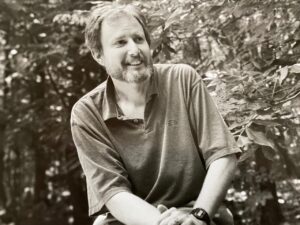
Robert Cox is a scholar and a gentleman. He also has a fire burning in his belly for protecting nature, confronting injustice, and empowering people, which fueled his long-time leadership in environmental politics, strategy, and influential communication. Robbie Cox served three times as president of the national Sierra Club in 1994-96, 2000-01, and 2007-08. He is Professor Emeritus at the University of North Carolina at Chapel Hill (UNC-CH), and as a scholar of activist rhetoric, Cox helped found the academic field of environmental communication.
Robbie and I recorded nearly eleven hours of his life history over Zoom during five interview sessions in September 2020, during the early months of the COVID-19 pandemic. Robbie’s inspiring stories of environmental activism produced a 253-page transcript, which includes an appendix with several photographs. The stories that Robbie shared in his oral history also emphasized the incredibly high stakes for our present moment of environmental politics, rhetoric, and civic engagement.
Cox was born in September 1945, in Hinton, West Virginia, where his early influences included roaming Appalachian forests and rivers as well as his family’s history of union organizing and work toward social justice. He was recruited to the debate team at the University of Richmond where, from 1963 to 1967, he studied communication, philosophy, history, and religion while also participating in civil rights protests. In 1970, Cox earned his Ph.D. in classical rhetoric studies from the University of Pittsburgh with a dissertation on the rhetorical structures of the Vietnam antiwar movement in which he actively participated. From 1971 to 2010, Cox was a Professor in the Department of Communication at UNC-CH where he helped establish the field of environmental communication and focused his research and teaching on argumentation, rhetorical theory, and social movements. Cox married Professor Julia Wood in 1975 when she also joined the UNC-CH faculty in the Department of Communication.
Video clip from Robert Cox’s oral history on first joining the Sierra Club in 1979
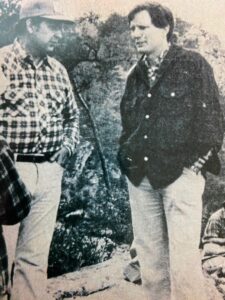
Upon Dr. Wood’s suggestion, Cox joined the Sierra Club in 1979 and, over time, he earned leadership positions at every level in the Club: as chair of the Research Triangle Group, as chair of the North Carolina Chapter, and as an elected member to the national board of directors for most years between 1993 and 2013, including three times as president of the national Sierra Club. Cox made significant contributions to passage in the US Congress of the North Carolina Wilderness Bill, to the Sierra Club’s early engagements in the environmental justice movement, to restructuring both the Club’s internal governance and its volunteer structure, as well as helping lead Sierra Club engagements in national politics, particularly during his times as Club president. In this oral history, Cox discusses all of the above, with a focus on leveraging influential communication and strategy, while also sharing his experiences hiking and trekking in the Himalayas, in the mountains of Europe, and in the Appalachian Mountains.
Robbie Cox’s oral history is significant for detailing the environmental activism and political strategies of one of the most influential volunteers in recent Sierra Club history. Some of the themes throughout Robbie’s oral history include the profoundly democratic nature of the Sierra Club, details on the Club’s geographically diverse grassroots activism, as well as numerous ways that volunteer environmentalists work together to shape state and national legislation. Robbie also reconstructed the ways he balanced his double life as UNC professor with his life as an environmental activist, especially through his work in Sierra Club media campaigns. He recounted his decades as a nationally elected volunteer leader in the Sierra Club, as told through the perspective of an academic scholar of rhetoric and communications. And throughout, Robbie shared stories of direct action for environmental causes at all levels of Sierra Club engagement, from local to national.
Video clip from Robert Cox’s oral history on passing the North Carolina Wilderness Act in 1984
The in-depth, life-history approach used in this oral history reveals ways that Robbie’s personal influences and his engagements in the Sierra Club evolved over time. For instance, Robbie’s family history of labor activism instilled in him the power of people and the importance of social justice. Similarly, his participation on debate teams shaped substantially his education and academic work, while also playing a central role throughout his life as a political and environmental activist. Robbie’s interview also explored the Sierra Club’s and his own personal engagements with environmental justice, including his attendance at the First National People of Color Environmental Justice Leadership Summit in 1991, his leveraging of media in the national Sierra Club’s partnership with “Jesus People Against Pollution” in Mississippi, as well as his experiences on toxic tours of colonias in Matamoro, Mexico, along with other actions against the negative results of neoliberal free trade agreements.
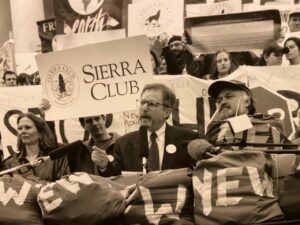
Robbie also shared insider details on several significant moments in the Sierra Club’s recent history. He recounted the Club’s severe financial crises in the 1990s that resulted in his work to reorganize the Club’s internal governance through Project Renewal as well as the Club’s volunteer structures via Project ACT. Robbie recounted his central role in the Sierra Club’s efforts to combat the de-regulatory and anti-environmental Congressional agenda in wake of Newt Gingrich’s Republican take-over of Congress in the 1990s, as well as Robbie’s personal role in securing the Sierra Club’s endorsement of Al Gore, for whom Robbie campaigned in 2000. Robbie also detailed the central role he played in the Groundswell Sierra campaign in the early 2000s to resist a take-over of the Sierra Club by anti-immigration and white supremacist forces. And as the world warms and the seas rise, Robbie discussed ways that the Sierra Club has confronted the compounding crises of climate change in the twenty-first century. Robbie’s decades of environmental activism provides a lens on ways the environmental movement has evolved over time from its early focus on wild lands, to concerns about human health, to engagement on issues of environmental justice, to the modern complexities of climate change. Robbie also reflects on the contemporary Sierra Club’s internal and external challenges in its ongoing work for equity, inclusion, and justice.
Video clip from Robert Cox’s oral history on delivering to Congress the Environmental Bill of Rights with 1.2 million signatures in 1995
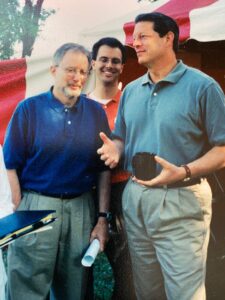
Back in the summer of 2020, when I spoke with Carl Pope, former Sierra Club executive director, to prepare for Robbie’s oral history, Pope recalled Robbie’s exceptional leadership and effectiveness. When “Professor Cox” first won election to the national Sierra Club board of directors in the 1990s, Pope described Robbie’s presence as “immediately noticeable.” Pope told me how Robbie used his expertise in rhetoric to unify people and advance proposals for environmental action. “You could see Robbie work at a board meeting,” Pope remembered. “When he wanted to get the board to agree, he would offer some initial proposal tentatively, then let folks respond to it and let the room talk. Then he’d come back in and make the same proposal, but he changed two words to see if that worked. He’d keep playing with the proposal and make changes rhetorically, until he got something that would work for everyone.” The Sierra Club’s board of directors come increasingly from a variety of backgrounds across the United States. All directors are volunteers, not employed staff, but like much of the Sierra Club staff, many Club directors consider themselves to be full-time environmental activists. As Carl Pope noted, however, most Sierra Club directors “are not professional communicators. People would talk past each other. Robbie’s skill on the board lubricated that process, which was phenomenally helpful. If anyone wanted to get something done, you asked Robbie.” Indeed, Robbie Cox got things done.
Pope also described Robbie as a kind of environmental philosopher. “He wasn’t ideological,” Pope explained, “but surely, he had his own vision of where the Club should go.” Now, with this publication of Robbie Cox’s oral history, you too can have him tell you in his own words about his visions for the Sierra Club and the ways he mobilized constituencies to make a reality of his visions for environmental protection, political power, and justice.
ABOUT THE ORAL HISTORY CENTER
The Oral History Center of The Bancroft Library preserves voices of people from all walks of life, with varying political perspectives, national origins, and ethnic backgrounds. We are committed to open access and our oral histories and interpretive materials are available online at no cost to scholars and the public. You can find our oral histories from the search feature on our home page. Search by name, keyword, and several other criteria. Sign up for our monthly newsletter featuring think pieces, new releases, podcasts, Q&As, and everything oral history. Access the most recent articles from our home page or go straight to our blog home.
Please consider making a tax-deductible donation to the Oral History Center if you’d like to see more work like this conducted and made freely available online. While we receive modest institutional support, we are a predominantly self-funded research unit of The Bancroft Library. We must raise the funds to cover the cost of all the work we do, including each oral history. You can give online, or contact us at ohc@berkeley.edu for more information about our funding needs for present and future projects.
Podcast episode 3: “Environmental Justice for All” in The Bancroft Gallery exhibit VOICES FOR THE ENVIRONMENT: A CENTURY OF BAY AREA ACTIVISM
Listen to podcast episode 3, “Environmental Justice for All,” or read a written version of this podcast episode below.
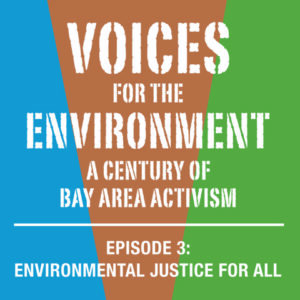
Voices for the Environment: A Century of Bay Area Activism is a gallery exhibition in The Bancroft Library that charts the evolution of environmentalism in the San Francisco Bay Area through the voices of activists who advanced their causes throughout the twentieth century—from wilderness preservation, to economic regulation, to environmental justice. The exhibition is free and open to the public Monday through Friday between 10am to 4pm from Oct. 6, 2023 to Nov. 15, 2024, in The Bancroft Library Gallery, located just inside the east entrance of The Bancroft Library. Curated by UC Berkeley’s Oral History Center, this interactive exhibit is the first in-depth effort to showcase oral history along with other archival collections of The Bancroft Library.
This exhibition includes three podcast episodes that offer deeper narratives to supplement the archival posters, pamphlets, postcards, photographs, oral history recordings, and film footage that are also presented in the gallery. Please use headphones when listening to podcasts in The Bancroft Library Gallery.
A written version of podcast episode 3 is included below.
Listen to episode 3: “Environmental Justice for All” on SoundCloud.
PODCAST EPISODE SHOW NOTES:
Episode 3: “Environmental Justice for All.” This podcast episode accompanies a section of the Voices for the Environment exhibition that explores how, in the 1980s and 90s, communities of color in the Bay Area fought against environmental racism by creating new organizations, such as the Urban Habitat Program, to demand environmental justice—the equal treatment and meaningful involvement of all people in environmental decision-making. In the city of Richmond, activists in the West County Toxics Coalition and the Asian Pacific Environmental Network, or APEN, organized against toxic threats from the area’s petrochemical and hazardous waste facilities. Environmental justice activists helped transform the American environmental movement from one focused mostly on landscapes to one that increasingly includes the health and wellbeing of historically disenfranchised people.
This podcast episode features historic interviews from the Oral History Center archives in The Bancroft Library at UC Berkeley, including segments from oral history interviews with Carl Anthony, Pamela Tau Lee, Henry Clark, and Ahmadia Thomas, all recorded in 1999 and 2000. This episode was narrated by Sasha Khokha, with thanks to KQED Public Radio and The California Report Magazine.
This podcast was produced by Todd Holmes and Roger Eardley-Pryor of the Oral History Center of The Bancroft Library at UC Berkeley, with help from Sasha Khokha of KQED. The album and episode images were designed by Gordon Chun.
WRITTEN VERSION OF PODCAST EPISODE 3: “Environmental Justice for All”
Pamela Tau Lee: We cannot be afraid to talk about environmental racism. We cannot be afraid to discuss that, talk about what it means: the discrimination of communities in environmental policy and being left out of the process.
Sasha Khokha: What does justice look like? Whose lives matter? And how does that relate to the environment? In the 1980s and 90s, concerns about toxic industrial waste led communities of color in the Bay Area, and across the nation, to create new organizations and demand environmental justice—the equal treatment and meaningful involvement of all people in environmental decision-making.
Pamela Tau Lee: What we need to deal with is the racism that is the root cause of why industry was targeting communities of color: because communities of color would not have any power; that it’s much more acceptable to dump this stuff in communities of color. So if we shied away from talking about racism, we would then not be able to articulate the realities, and we felt it was racism.
[music]
Sasha Khokha: Welcome to Voices for the Environment: A Century of Bay Area Activism. This podcast accompanies an exhibition in The Bancroft Gallery at UC Berkeley that’s the first major effort to bring together both the oral history and archival collections of The Bancroft Library. The voices you’ll hear were recorded by UC Berkeley’s Oral History Center, founded in 1953 to record and preserve the history of California, the nation, and our interconnected world.
Voices for the Environment traces the evolution of environmentalism in the San Francisco Bay Area across the twentieth century, and highlights ways that Bay Area activists have been on the front lines of environmental change.
This is our third and final episode, called “Environmental Justice for All.” I’m your host, Sasha Khokha, from KQED.
[harmonica blues music]
Sasha Khokha: Communities of color have long confronted environmental racism—the disproportionate burden of toxic waste and industrial pollution in neighborhoods that are mostly low income and home to BIPOC folks. But up until the 1980s, the big players in the environmental movement focused on other issues, like preserving redwood groves or protecting bay shoreline from new construction.
Pamela Tau Lee: I think many of the mainstream organizations, you know, they don’t focus on people. They focus on the ecology and other natural resources.
Sasha Khokha: That’s Pamela Tau Lee, a environmental and labor activist from San Francisco whose oral history you’re hearing.
Pamela Tau Lee: These predominantly white organizations did not want to really acknowledge that there was a different experience felt by communities of color.
Sasha Khokha: Take the city of Richmond, where more than 75% of residents identified as people of color in the 2022 census. Located along the bay above Berkeley and Oakland, Richmond has been home to the Chevron oil refinery since 1902. A host of other polluting industries were established there, too. As a result, people in Richmond experience higher levels of pollution and toxins, and have less access to healthy environments to live and play. In the mid-1980s, Richmond residents formed the West County Toxics Coalition. It’s a multi-racial organization aimed at empowering the community to have a greater voice in the environmental issues impacting their neighborhoods.
Henry Clark: You know, like anyone born and raised in North Richmond, we know that there was environmental problems there, you know, over your whole lifetime. So it was quite only logical when the West County Toxics Coalition was formed and they began to organize in North Richmond.
Sasha Khokha: That’s Henry Clark, who grew up in North Richmond. In 1986, after earning his Ph.D. in religious studies, Clark became executive director of the West County Toxics Coalition, and he led it for more than three decades. As a kid in North Richmond, Henry Clark’s home was directly next door to the Chevron oil refinery.
Henry Clark: I can remember clearly waking up many mornings and finding the leaves on the tree burnt crisp overnight from chemical exposure, or you know, going outside and the air would be so foul that you would literally have to grab your nose and try to not breathe the air and go back in the house and wait until it was cleared up. Those type of situations, you know, were a common experience.
Sasha Khokha: Ahmadia Thomas also knows about the foul air in Richmond. She moved there in the mid-1970s and was active in community organizing.
Ahmadia Thomas: Well, then I first came here, I didn’t know, but I used to smell these terrible odors. And I’d say, “What’s that?” And my husband said, “We all smelled it all the time, and we ain’t never made no kick about it.” But they didn’t know what they were smelling. And they were terrible odors: you know ones that smell like sulfur once in a while. Terrible odors out here, after I got out here. When I first came, I didn’t remember smelling all this stuff, but boy, after I was out here a while, I really got environmentally conscious.
Sasha Khokha: Thomas joined the West County Toxics Coalition, too, in part because she was concerned about how Richmond’s industrial pollution was affecting her health—and her neighbors’ health.
Ahmadia Thomas: Like a lot of people had long-term illnesses. Like, these illnesses we don’t know whether they’re short-term or long-term. But if you’ve been affected, say, five years ago and you’re still affected, well now that’s a long term. But, see, a lot of them has been affected. Children, too.
Sasha Khokha: Regular chemical exposures contributed to those illnesses, and so did the periodic accidents, fires, and explosions at the Chevron refinery.
Ahmadia Thomas: And then when they started having the accidents—whoo! There was always a fire or accident. It would be on the TV or in the paper: “There was an accident, but it wasn’t no harm to your health.” And that ain’t true! [laughs] Got to hearing that.
Sasha Khokha: Here’s Henry Clark again.
Henry Clark: You know, these chemical disasters, they do affect people’s lives and people do die from them. You usually don’t hear about the deaths that do occur. You now, they just end up being faceless people whose families may be aware of it, but most of the time you don’t hear about that. Nor do you really even get a good sense of the health impacts, because usually there’s no type of comprehensive health studies that are done or conducted after these disasters.
Sasha Khokha: But the health studies that have been conducted are clear.
Henry Clark: I do know that there’s a 33 percent higher than state average lung cancer rate throughout the Richmond area stretching actually throughout the county, stretching through the industrial corridor.
Sasha Khokha: Here’s Carl Anthony. He’s an architect, a city planner, and a former professor at UC Berkeley.
Carl Anthony: The communities get it. You don’t have to have a Ph.D. to figure out if you have asthma rates five or six times the regional average, it’s clearly symbolic of racism. It is an environmental racism.
Sasha Khokha: With so many other Bay Area groups focused on land, trees, and wildlife, Carl Anthony saw the need for a new organization to deal with the complex urban issues confronting communities of color.
[blues music]
In 1989, Anthony co-founded the Urban Habitat Program to focus on people who lived in cities. He envisioned it would be as multi-racial and multicultural as the Bay Area where he lived. And to better understand the connections between social injustice, economic inequality, and environmental racism, Anthony also helped create a groundbreaking journal, first published on Earth Day in 1990, called Race, Poverty, and the Environment.
Carl Anthony: When we began the Race, Poverty, and the Environment journal, we started looking at these. What is the energy cycle? We began to see that the whole system of extracting energy, distributing it, consuming it, and waste, at every step were huge social issues.
Sasha Khokha: Like the chemical pollution near oil refineries, or the health and safety issues for workers there, or the high cost of energy for low income people: all intertwined social and environmental issues. As executive director of the Urban Habitat Program, Carl Anthony built upon the Bay Area’s progressive and environmental traditions, with a focus on community-led decision making and public investment in historically disenfranchised neighborhoods. But, the more Anthony engaged with issues of environmental justice, the more problems he saw in the ways that mainstream, mostly white American environmental activists understood their own history.
Carl Anthony: There was a deep problem in the myth of the environmental movement, the story of the environmental movement, as having grown out of a certain understanding about the settlement of North America. Put really briefly, the settlement began in New England when the Puritans arrived, and then they found an empty wilderness, and they cleared the forests and built the dams and the towns, and came all the way across the country, and then they looked back and saw how much devastation they had made.
Sasha Khokha: By the start of the 20th century, that environmental devastation inspired the early conservation movement, led by preservationists like John Muir. But for Carl Anthony, this narrative focused too much on wilderness and the conservation of public lands, and not enough on the history of race and American expansion.
Carl Anthony: You know, if you look back a little bit, you say, “Wait a minute, hold it, what’s wrong with this model?” First of all, the North American continent wasn’t empty. There were ten million people here. So where do they fit in this story? And then, millions of people were brought from Africa who worked the land—now it has been eighteen generations—where do they fit in this story? And in particular, from the point of view of the racial issues, the things that were missing in the John Muir model was that this was the end of manifest destiny. It was the end of the frontier wars with the Indians. These were the years when there was rampant racism against Chinese people and against Japanese people in California; the years when Jim Crow was established, and the national parks were set up that were white only.
Sasha Khokha: If the old land-focused narrative of American environmentalism ignored social and racial issues, it also overlooked the urban issues that Carl Anthony was so passionate about.
Carl Anthony: So, the point I’m making about cities is that the environmental movement took off in many ways by saying, “We’re not connected with that whole thing, that mess around the cities. We’re not going to deal with that.” So there was this big hole. But in many ways, the issues that people are complaining about—whether it’s global warming, or whether it’s the squandering of, you know, chopping down the trees, whatever it is—are rooted in the way that we’re living in cities. So I felt that by setting up the Urban Habitat Program, we would then be in the position to be able to say, “This is how we need to think and act in relationship to restoring our cities. Here’s how we’re going to address the environmental issues; here’s how we’re going to address the social justice issues; here’s how we are going to address the economic issues. And because you care so much about biodiversity and energy efficiency and all these things, we would like to invite you to participate with us in doing that.”
[music]
Sasha Khokha: Bay Area activists soon discovered they weren’t alone in the fight for environmental justice. Shortly after starting the Urban Habitat Program, Anthony learned about the Toxic Wastes and Race report published in New York by the United Church of Christ’s Commission on Racial Justice. That analysis showed how government agencies across the nation consistently located toxic waste facilities in communities of color. And when the Church and other groups began to organize a national summit on environmental justice, the Bay Area sent a huge contingent.
Pamela Tau Lee: . . . 1991, in Washington DC, was so powerful to see people of color in this room talking about their struggles for justice in this country. I had not heard anything as dynamic and comprehensive since the Civil Rights [Movement] when I was young.
Sasha Khokha: Pamela Tau Lee, then a labor activist in San Francisco, attended that First National People of Color Environmental Leadership Summit.
Pamela Tau Lee: When you came into that room, you saw native people from Alaska, the deserts of Nevada, the Shoshone tribe. You saw African Americans who lived in small towns in the middle of Alabama, from the South, New Orleans, with African Americans from Harlem, and Detroit, and South Central Los Angeles. You saw brown people from Puerto Rico, from the border, together with Chicanos from New Mexico and California and farmworkers.
Sasha Khokha: At the summit, leaders of color shared examples of environmental racism from across the country, and they discussed what to do about it.
Pamela Tau Lee: People were there to articulate, what is it that we are experiencing? And what is it that we want? And what it is that we stand for? One is we cannot be afraid to talk about environmental racism. In many of the discussions when we start to talk with the traditional environmentalists, who are mainly white, or the government, they were very afraid of that term. And we said we cannot be afraid to discuss that, talk about what it means: the discrimination of communities in environmental policy and being left out of the process. The mainstream environmentalists, they didn’t want us to say anything about racism. They wanted us to use the word “equity.” And what we need to deal with is the racism that is the root cause of why industry was targeting communities of color: because communities of color would not have any power, that it’s much more acceptable to dump this stuff in communities of color. So if we shied away from talking about racism, we would then not be able to articulate the realities, and we felt it was racism.
Sasha Khokha: As Pamela Tau Lee recalled, activists at the summit also discussed a way forward: demanding justice and taking action.
Pamela Tau Lee: What we wanted industry and the government to use as the criteria for action was the facts: that there is a Superfund site there, that the soil is contaminated, that children are sick, that people have cancer, that the air quality here is bad. And therefore, do something! And what we were coming up against was, you know, “Prove it. Prove that the people are sick. Prove it.” And these communities don’t have the resources to do that. The government and industry knows these people are sick, knows the air quality is bad, knows the soil is contaminated, and should take action. So that was another key component, illustrated very wonderfully in the Principles of Environmental Justice.
Sasha Khokha: The First National People of Color Environmental Leadership Summit, and the Principles of Environmental Justice created there, reshaped the trajectory of American environmentalism. It inspired a new generation of activists who put people—not just landscapes—within the environmental agenda. For Pamela Tau Lee, attending that 1991 summit motivated her and others to form a new Asian American organization for environmental justice that would work with people here, in the Bay Area.
Pamela Tau Lee: We came back, Asians came back, we talked together, networked together, and after three years, I think, we formed the Asian Pacific Environmental Network [APEN], which has done very powerful work . . . [with] the ability to begin to articulate what environmental justice looks like for the Asian communities in this country.
Sasha Khokha: The Asian Pacific Environmental Network, or APEN, formed in 1993, and its initial work began in Richmond. APEN helped the Laotian immigrant community from Southeast Asia gain a voice in the larger efforts to address the toxic pollution caused by the Chevron refinery and other industrial sites in the city. Today, APEN continues organizing communities for environmental justice throughout the Bay Area.
[music]
By the mid-1990s, the demands of the environmental justice movement reached the White House. On February 11, 1994, President Bill Clinton signed an Executive Order directing federal agencies to “identify and address the disproportionately high and adverse human health or environmental effects of their actions on minority and low-income populations.” Here’s Carl Anthony reflecting on that moment.
Carl Anthony: Well, I think it was, first of all, an incredible achievement. And I can tell you, the ones that did it in the environmental justice movement were virtually uncompromising that the grassroots people have to be at the table. I mean, [they said], “To hell with all these experts and all these consultants and all these people.” They brought the people in who were suffering from the asthma, and respiratory conditions, and from the cancer.
Sasha Khokha: While the executive order didn’t mandate specific actions by law, Pamela Tau Lee thought it was an important benchmark.
Pamela Tau Lee: I think that President Clinton’s order had a very big impact. Many people want to have more, but there is no way that it was going to become law. But that executive order, I think, gave the movement opportunity to advocate the formation of a national environmental justice advisory committee within the EPA. That enabled the White House to call an interagency body to regularly discuss this. And I think that, you know, it’s not like spectacular changes, but I think that it has made a difference.
[music]
Sasha Khokha: By the late 1990s, when most of the oral histories you’ve heard here were recorded, several environmental justice groups had formed in the Bay Area. Like PODER, a Latinx-led group in San Francisco whose name stood for People Organizing to Demand Environmental and Economic Rights. And PUEBLO, which stood for People United for a Better Life in Oakland. And the Silicon Valley Toxics Coalition in the south bay. These activists often supported each other’s efforts. Here’s Henry Clark.
Henry Clark: Here in the Bay Area, there’s different groups in Oakland or San Francisco that do similar type of work. And so when they have public hearings, or protests, demonstrations, or activities, we go and support their works, send people there to support their work. And when we would have activities here in the Richmond area, they send people over to support our work, so building relationships to mutual support.
Sasha Khokha: Working to integrate environmental, social, and economic change for justice is difficult. So activists celebrate their victories, large and small. Like in the year 2000, when APEN’s Asian Youth Advocates and its Laotian Organizing Project in Richmond were able to create community warning systems in multiple languages for when industrial accidents occur. Or in 1997, when the West County Toxics Coalition shut down the Chevron Ortho Chemical Company’s toxic waste incinerator, which had been belching out pollution for decades.
Henry Clark: That campaign was linked to the Chevron Ortho Chemical Company incinerator that had been operating since 19—I believe—67, on a temporary permit. And Chevron was in the process of getting a permit to expand the hazardous waste that was being burned in that incinerator. The West County Toxics Coalition felt that the company should not get a permit to expand their waste burning. In fact, they should actually decrease the waste that was being incinerated. So we organized a campaign to do public education. We received word that Chevron was withdrawing their permit application to expand the incinerator, and that the incinerator was going to be closing down. And so the incinerator has been closed and dismantled as of June of 1997.
[music]
Sasha Khokha: But creating change doesn’t happen quickly. Most of the big, mainstream and mostly white environmental organizations have been slow to expand their activism, their funding, their membership, and their leadership to include BIPOC folks. Even so, since the 1980s and 90s, activists for environmental justice have unequivocally transformed the U.S. Environmental movement from one focused on trees, and landscapes, and sensitive habitats, to one that increasingly includes the health and wellbeing of historically disenfranchised people.
Carl Anthony: What I consider the most important work that I’m involved in is reframing the environmental story.
Sasha Khokha: Here’s Carl Anthony again.
Carl Anthony: There will have to be a much more systematic acknowledgement that environmental and social issues are connected; they are not separate. In my view, that means the environmental justice movement in some fundamental way must become the mainstream of the environmental movement. And I think the environmental movement has had the enormous luxury of being a white movement. But if we’re really serious about changing the dynamics at a global scale, there’s no way that it can keep going as a white movement.
Sasha Khokha: Bay Area environmental justice organizations, like the Urban Habitat Program, have shown a way for activists to build upon their past while still moving forward, together.
Carl Anthony: We kind of represented that model. That yes, you could in fact be advocates of social justice, you could in fact be militant about social justice, and still be an advocate of environmental preservation.
Sasha Khokha: And Bay Area leaders like Henry Clark and Pamela Tau Lee were on the cutting edge of helping the public understand that environmental justice means justice for all.
Henry Clark: When you’re looking at it from an environmental justice perspective, or justice period, the bottom line is that you work out a situation where it will be just for everyone involved, and that’s really what you have to keep the major focus on, especially when you’re trying to deal with situations that have been historically unjust.
Pamela Tau Lee: Many wealthy whites were content for this to be in the back yards of poor communities of color. Well, we were not going to say, “No, we don’t want it. We’re going to put it in rich, white people’s backyards.” That’s not something that we were going to stand for. We were going to always fight for the protection of all, public health of all, the ecology for all.
Sasha Khokha: After all, as our shared world becomes more interconnected, these are issues that affect all of us. Here’s Carl Anthony again.
Carl Anthony: But ultimately, as we get into the twenty-first century, this is the story of how the whole human race is going to address the shadow side of the industrial revolution. It’s not just a Black story. The fact of the matter is that all of us who benefited from the way the industrial revolution had functioned, the gifts that it has given us, are participants in this problem of the shadow side of consumption and waste and all this. Black people just happen to have, you know, kind of an angle or an insight on a piece of this.
[music]
Sasha Khokha: Our relationships with the world around us define who we are. So do the relationships we have with each other. Over the last century, Bay Area activists helped advance our understanding of both of these kinds of relationships—from preserving California’s ancient forests, to regulating economic development, to pushing for the health of communities of color as an environmental issue. Today, the social and environmental challenges we face appear even more daunting than the ones earlier generations had to face. Only by working together and building on lessons from the past can we work toward the solutions we need to thrive in the twenty-first century and become the newest Voices for the Environment.
[music]
You’ve been listening to “Environmental Justice for All,” the third and final episode in the podcast accompanying Voices for the Environment: A Century of Bay Area Activism. It’s an exhibition in The Bancroft Gallery at UC Berkeley that runs from October 2023 through November 2024. This episode featured historic interviews from the Oral History Center archives in The Bancroft Library at UC Berkeley. It included segments from oral history interviews with: Carl Anthony, Pamela Tau Lee, Henry Clark, and Ahmadia Thomas. To learn more about these interviews and the Oral History Center, visit the website listed in the show notes. This podcast was produced by Todd Holmes and Roger Eardley-Pryor, with help from me, Sasha Khokha. Thanks to KQED Public Radio and The California Report Magazine. I’m your host, Sasha Khokha. Thanks so much for listening!
End of Podcast Episode 3: “Environmental Justice for All”
ABOUT THE ORAL HISTORY CENTER
The Oral History Center of The Bancroft Library preserves voices of people from all walks of life, with varying political perspectives, national origins, and ethnic backgrounds. We are committed to open access and our oral histories and interpretive materials are available online at no cost to scholars and the public. You can find our oral histories from the search feature on our home page. Search by name, keyword, and several other criteria. Sign up for our monthly newsletter featuring think pieces, new releases, podcasts, Q&As, and everything oral history. Access the most recent articles from our home page or go straight to our blog home.
Please consider making a tax-deductible donation to the Oral History Center if you’d like to see more work like this conducted and made freely available online. While we receive modest institutional support, we are a predominantly self-funded research unit of The Bancroft Library. We must raise the funds to cover the cost of all the work we do, including each oral history. You can give online, or contact us at ohc@berkeley.edu for more information about our funding needs for present and future projects.
